Missouri is the home of many species of snake. The exact count is in the air and depends on if you count subspecies. Most sources give a range of 46 species, including 5 Venomous ones.
I will be covering how to identify the species, where you can find them, what they eat, and more.
This guide is organized by genus and all subspecies will be listed in bold under the same listing so you can easily find out more about each one.
- Non-venomous Snakes
- Kingsnakes (Lampropeltis)
- Hognoses (Heterodon)
- Garter Snakes (Thamnophis)
- Water Snakes (Nerodia)
- Brown Snakes (Storeria)
- Green Snakes (Opheodrys)
- Rat Snakes (Pantherophis)
- Ring-necked Snakes (Diadiophus)
- Bull Snakes (Pituophis)
- Coachwhips (Masticophis)
- Scarlet Snakes (Cemophora)
- Kirtland's Snake (Clonophis)
- Racers (Coluber)
- Lined Snakes (Tropidoclonion)
- Flat-headed Snakes (Tantilla)
- Crayfish Snakes (Regina)
- Mud snakes (Farancia)
- Groundsnakes (Sonora)
- Rough Earthsnakes (Haldea)
- Smooth Earthsnakes (Virginia)
- Wormsnakes (Carphophis)
- Venomous Snakes
- Frequently Asked Questions
- Conclusion
Non-venomous Snakes
Non-venomous snakes are snakes that do not have venom that can harm humans.
Some species have weak venom, but it is only used for hunting and would not harm a person unless they were allergic to the venom.
Kingsnakes (Lampropeltis)
Prarie Kingsnake (Lampropeltis calligaster calligaster)

Prairie kingsnakes are common to virtually all of Missouri.
They are 30-42 and tan or gray with numerous black-bordered brownish blotches on the back and sides. The belly is yellow with brown markings. They eat a wide range of prey including other snakes.
They are sometimes mistaken for the elaphe guttata or young copperheads, but even baby copperheads have the characteristic hourglass marking.
A defensive prairie kingsnake will rattle its tail in leaf litter to sound more threatening. They will also strike.
Speckled Kingsnake (Lampropeltis holbrooki)
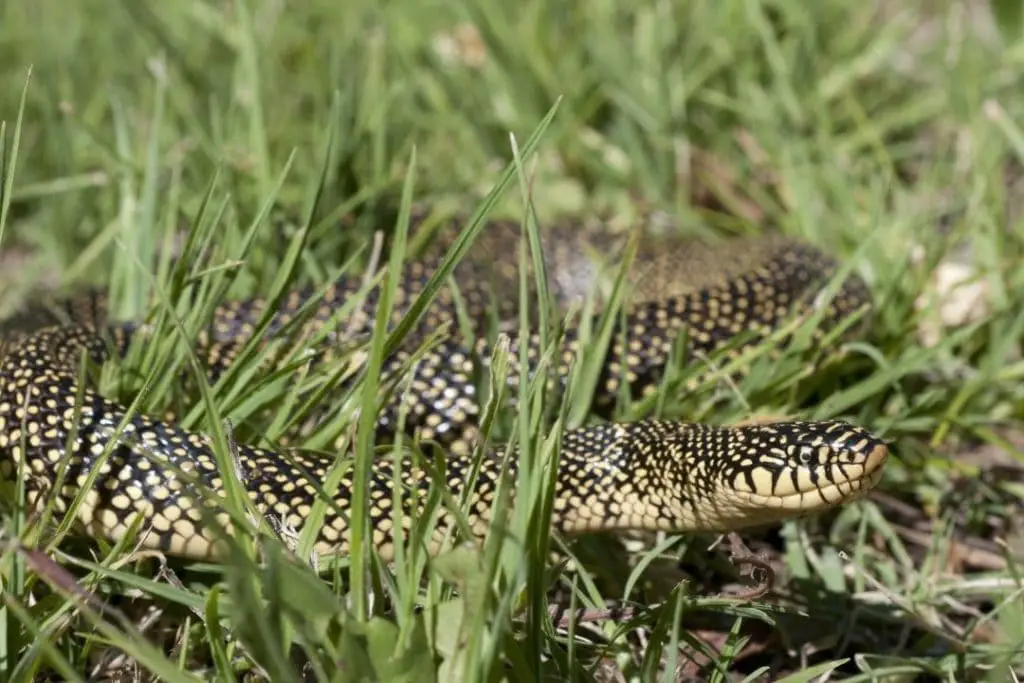
Speckled kingsnakes are 36-48 inches long with shiny black scales. They have white or yellow spots on the scales that give them a unique look.
Young snakes can have crossbars formed from the spots.
They live over most of the state in a wide range of habitats. They eat lizards, rodents, and snakes. They are also called salt-and-pepper snakes.
Eastern and Red Milksnakes (Lampropeltis triangulum)
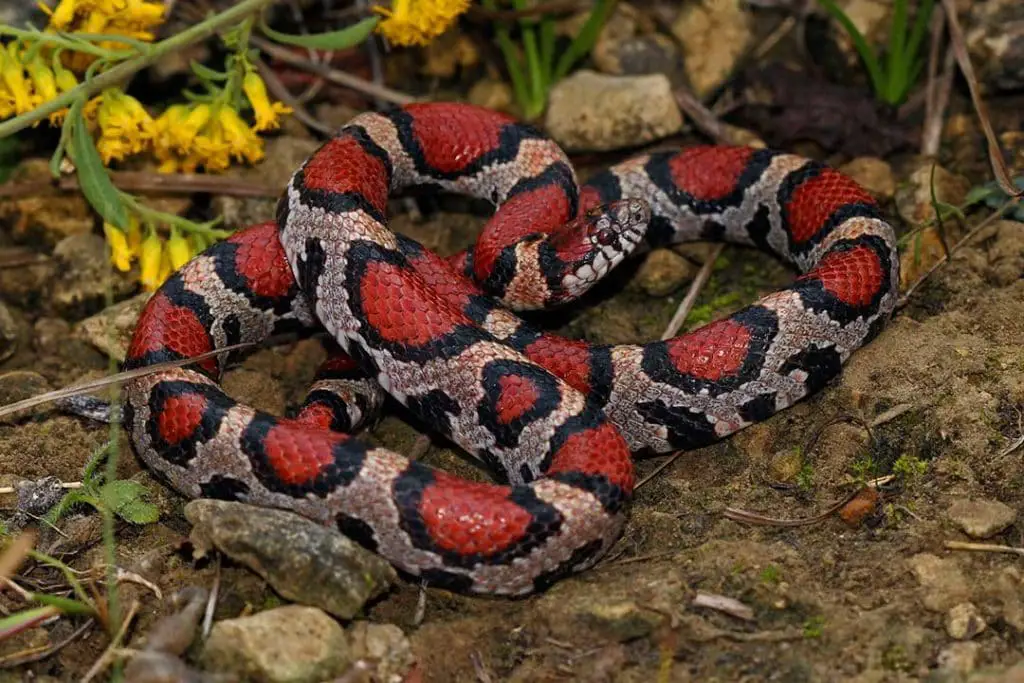
There are two subspecies of the eastern milksnake in Missouri. Both can be found statewide and eat a similar diet of small lizards, snakes, and rodents.
The Eastern milksnake (L. t. triangulum) is 24 to 35 inches in length with shiny scales.
They can be gray, tan, or cream with large brown blotches bordered by black.
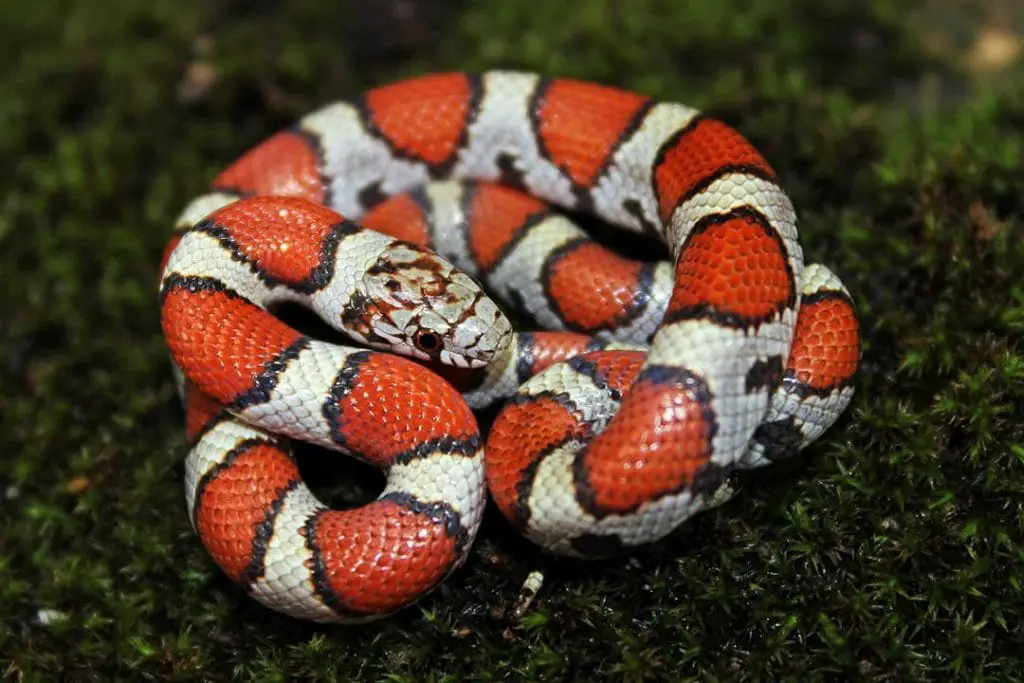
They live in woodlands, riverbeds, and rocky hills. The red milksnake (L. t. syspila) is 21-28 inches long and has a white background.
Large red blotches are bordered in black and look like rings if seen from above. They prefer cedar groves and rocky hillsides with some tree cover.
Western Milksnake (Lampropeltis gentilis)
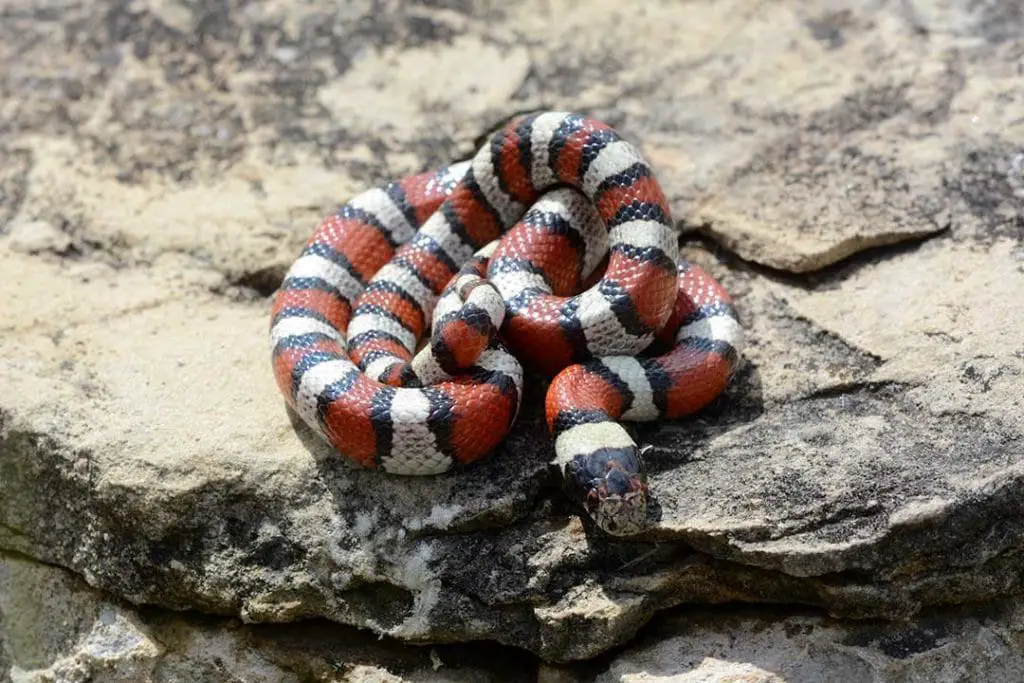
The only reports of the western milksnake are from the western border of Missouri. These snakes are typically 16-29 inches long as adults and are either cream or white.
They have red bands edged in black with smooth scales. Some of the rings can look incomplete.
They like grassland and rocky habitats where they hunt a wide range of vertebrate prey.
Eastern Black Kingsnake (Lampropeltis nigra)
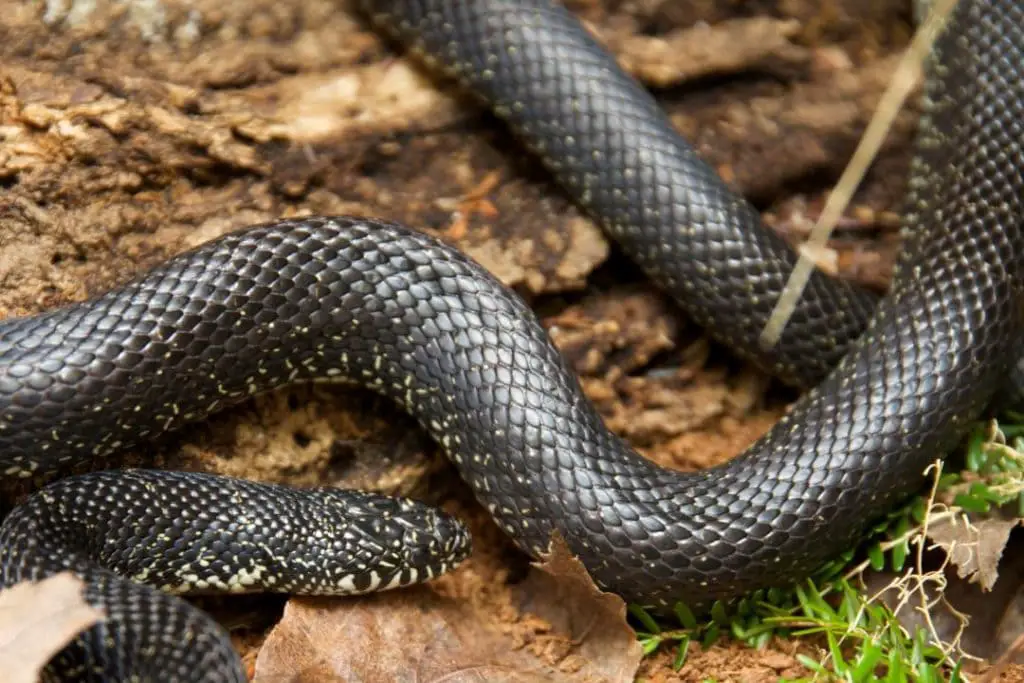
The eastern black kingsnake has been reported in the southeast of Missouri.
They are 36-45 inches long with a black body and some faint yellow or white speckling. This makes them easy to confuse for the speckled kingsnake, but the black kingsnake has much less visible patterning as an adult.
They live in open woodlands and rocky hills where they hunt lizards, snakes, and small rodents. This species used to be restricted to the east of the Mississippi River, but its range has extended.
Hognoses (Heterodon)
Eastern Hognose Snake(Heterodon platirhinos)
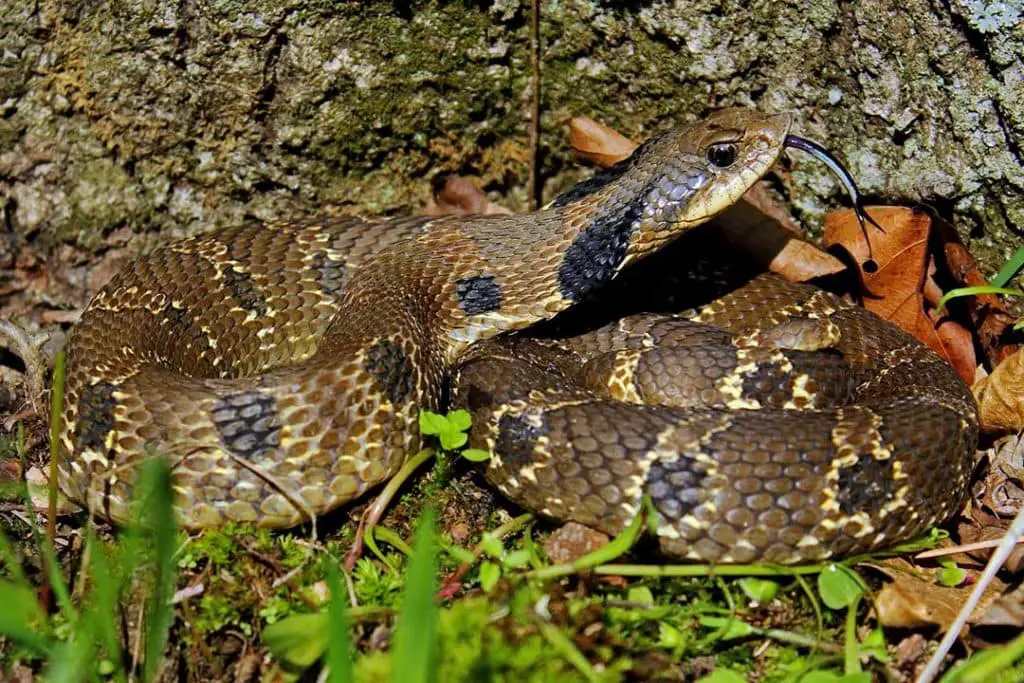
Eastern hognose snakes is 20-33 inches long and highly variable in appearance. Most animals have gray or brown background colors, but you may see orange or yellow animals.
Some animals have dark spots on the back. Hatchlings are much more colorful. Eastern hog nosed snakes are found statewide. They use their upturned snout to dig up toads, but they will also eat frogs and salamanders.
These snakes are known for their dramatic defense displays. They will hiss, spread out the head and neck, and may even play dead if they feel they have no other options. They rarely bite and tend to strike with the mouth closed.
Plains Hognose Snake (Heterodon nasicus nasicus)
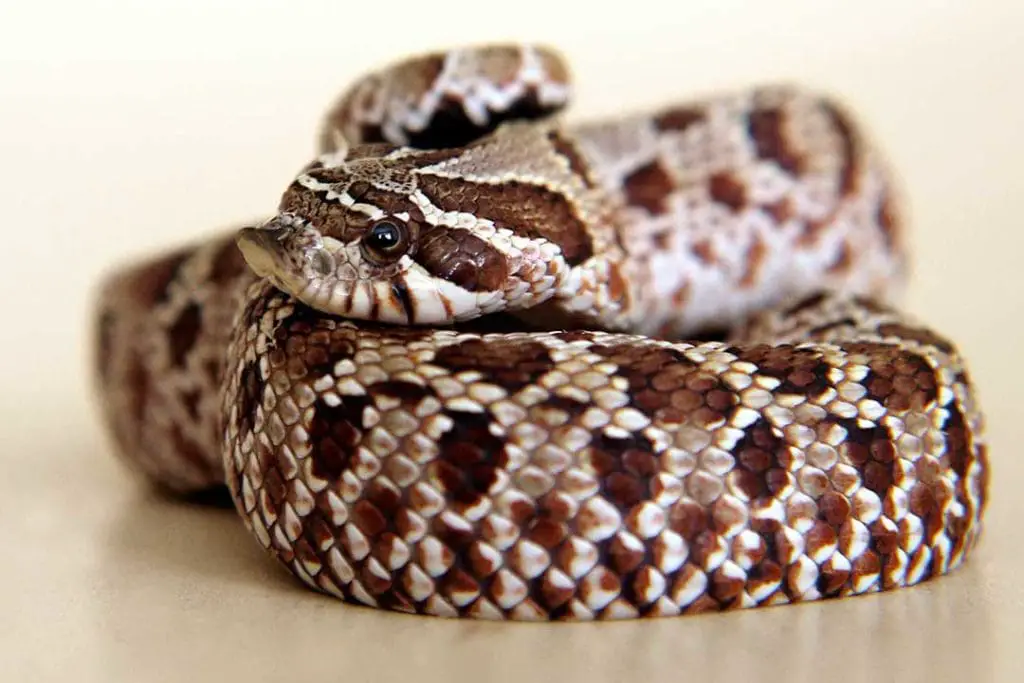
The plains hognose snake is also known as the western hognose snake and is a very popular pet snake.
They are between 16-25 inches on average. They have a tan or gray body with darker blotches body pattern on the back and sides. Females tend to have more blotches than males.
These nonvenomous snakes eat toads mainly but will take many small prey animals including snakes, lizard eggs, and small rodents. They have a strongly upturned snout that makes them easy to tell apart from the Eastern hognose.
They are rare in Missouri and are mainly found in the sandy loess hills of the northwestern counties. They haven’t been seen in Missouri and years and may be extirpated.
A small population of dusty hognose snakes (H. n. gloydi) can be found in the sand prairies of southeastern Missouri.
Garter Snakes (Thamnophis)
Plains Garter Snake (Thamnophis radix)

The plains garter snake is 15-28 inches long. The background color is gray, olive, or brown with three light stripes.
The light stripes along the side can be yellow, green, or blue while the stripe on the back is typically orange. The sides have rows of dark spots and the lips have black bars.
This common garter snake lives in the northwestern and north-central parts of Missouri. Another isolated population is found near St. Louis.
They live in wet meadows and marshes. These missouri snakes eat mainly earthworms, small fish, amphibians, and occasionally small rodents.
Eastern and Red-sided Garter Snakes (Thamnophis sirtalis)
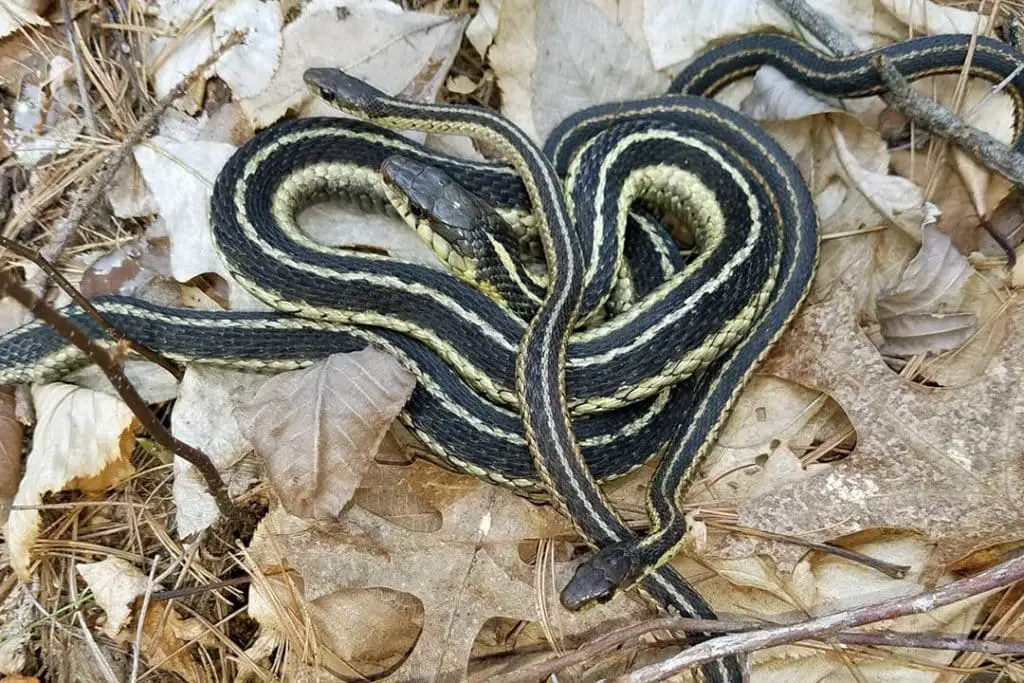
There are two subspecies of eastern garter snake in Missouri. Both are 18-26 inches long and eat earthworms, small fish, amphibians, and small mammals.
The eastern garter snake (T. s. sirtalis) is the most common garter snake, it is dark brown, black, greenish, or olive with three yellow stripes.
Some animals have rows of spots between the stripes. They live in the eastern half of the state. The red-sided garter snake (T. s. parietalis) has red or orange on the sides of its body.
They can be found in the prairies of western and northern Missouri.
Orange Striped Ribbon Snake (Thamnophis proximus proximus)

The orange striped ribbon snake is a very thin snake that is 20-30 inches long. The ground color is dark and it has three yellow or orange stripes down the body.
They frequently have a yellow or orange spot on the head. The belly is green or cream without any patterning. They can be found statewide in wooded areas close to bodies of water.
They eat small frogs, toads, salamanders, and fish. They may also eat earthworms on occasion. While ribbon snakes are a type of garter snake, the western ribbon snake tends to be thinner and have a white spot in front of the eye.
Water Snakes (Nerodia)
Plain-bellied Water Snake (Nerodia erythrogaster)
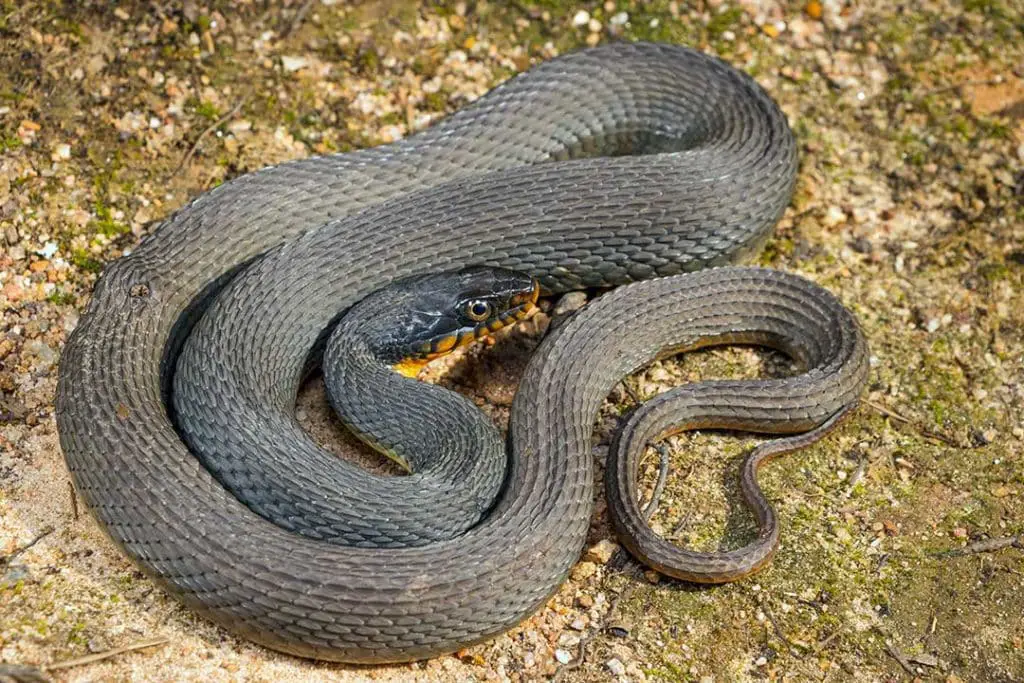
The plain-bellied water snake is 30-48 inches on average. They are greenish-gray, gray, or dark brown with very little patterning as adults. The belly is unpatterned and yellow or orange.
Juveniles have brown blotches along the back and sides that can join to form crossbars. They mainly live in the southeastern corner of the Mississippi River floodplain and along the southern border of Missouri.
The plain bellied watersnake eats mainly frogs and toads along with some fish and other prey.
This species used to have subspecies such as the yellow-bellied and blotched water snakes, but they are not currently recognized as valid.
Northern and Midland Water Snakes (Nerodia sipedon)
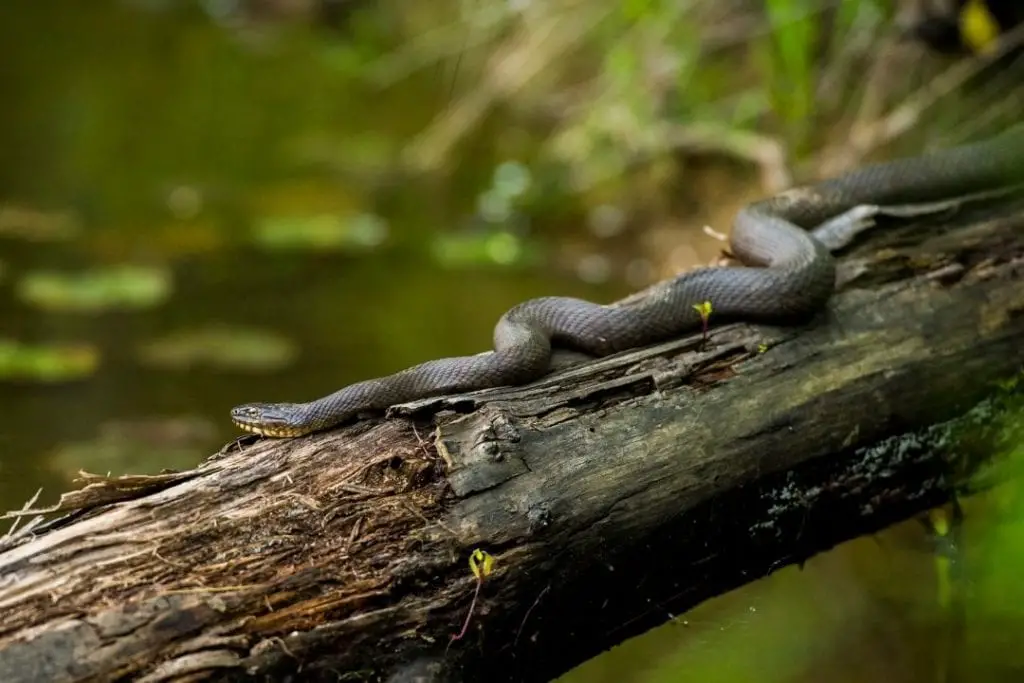
There are two subspecies of northern water snakes in Missouri. Both are 24-42 inches long and typically eat fish, frogs, and other amphibians. They have keeled scales and give live birth.
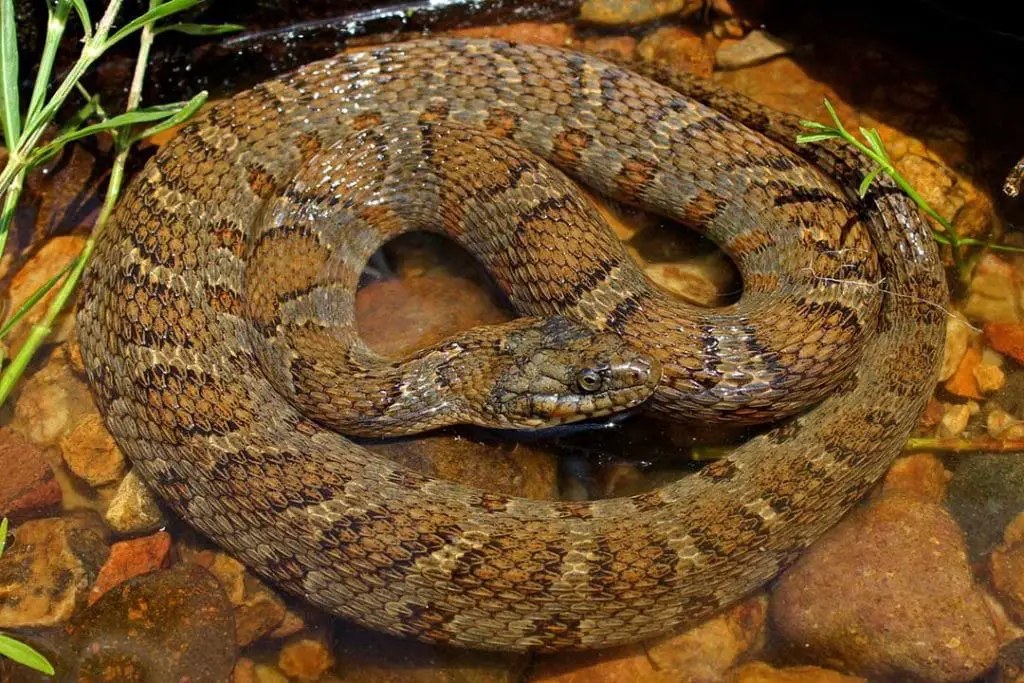
- The northern water snake (N. s. sipedon) is gray to reddish-brown with darker crossbands that fade to blotches near the tail. The belly is yellow or cream with rows of dark spots or half-moons. They live in the northern and western two-thirds of Missouri.
- The Midland water snake (N. s. pleuralis) is reddish-brown or tan with brown to reddish-brown crossbands. It lives in the southern and eastern third of the state and prefers clear, cool streams with gravel bottoms. They do breed with the northern water snake, so you may see hybrids.
Mississippi Green Water Snake (Nerodia cyclopion)
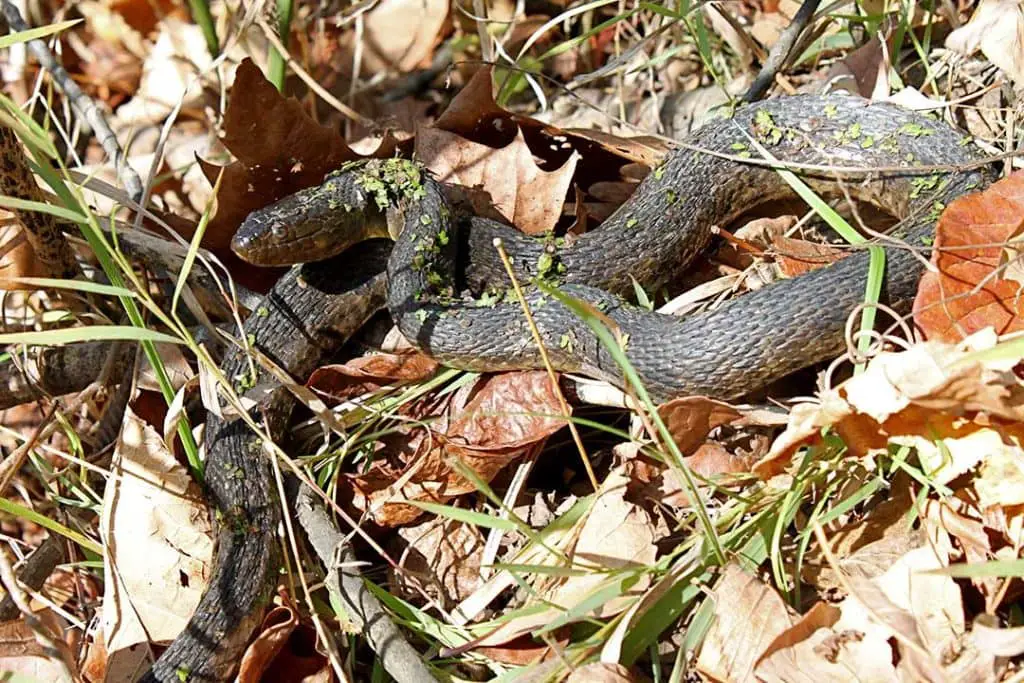
Mississippi green water snakes are 30-45 inches with a greenish-brown body with many brown markings. The belly is dark gray with yellow moon markings.
The Mississippi green water snake was once common in the southeast, but it may be locally extinct. They eat fish, crayfish, frogs, and salamanders.
They live mainly in cypress swamps and river sloughs, but much of this habitat has been destroyed.
Broad-banded Water Snake (Nerodia fasciata confluens)
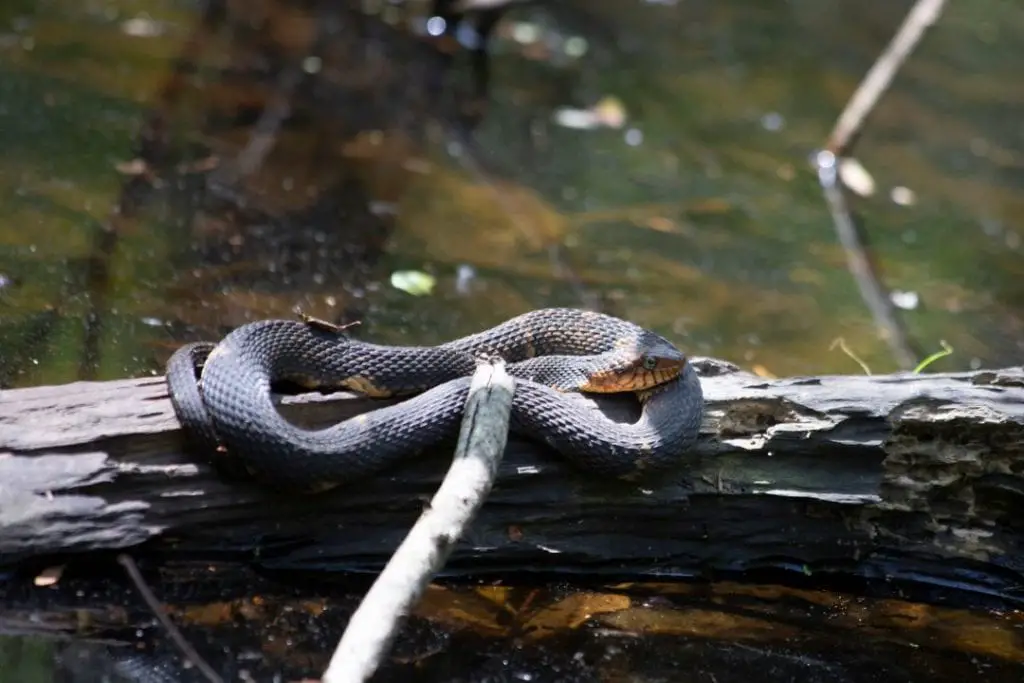
The broad-banded water snake is 22-36 inches long with irregular bands or blotches down the body.
The markings can be brown, reddish, or black with yellow separating them. The belly tends to be bright yellow with black patterning.
They only live in the southeastern corner of Missouri. They eat mainly fish and frogs and tend to stick close to water. If threatened, this snake will flatten its head and strike at its attacker.
Diamondback Water Snake (Nerodia rhombifer rhombifer)
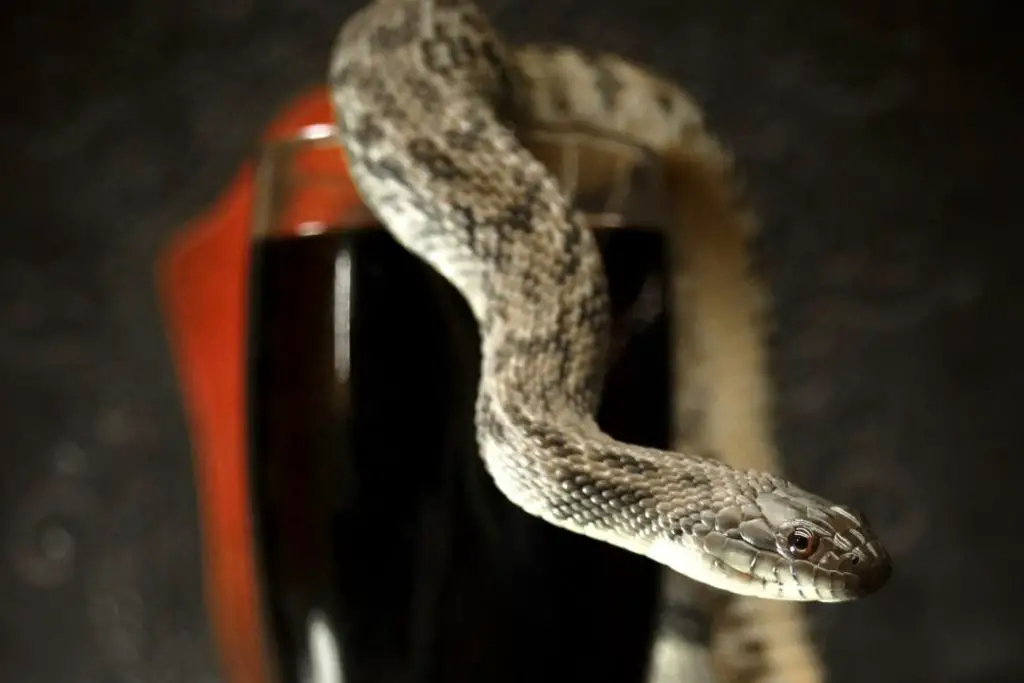
Diamondback water snakes are heavy-bodied snake that reaches 30-48 inches long.
They are light brown, gray, or dull yellow with diamond-shaped markings down the back. They also have darker brown blotches that can connect to form a chain-like pattern.
They have keeled scales and a yellow belly with dark brown spots or half-moons.
They are not found in the Ozarks but have a scattered range. They can be found in the southeastern corner, up the Mississippi River, and up to northern and western Missouri.
They aren’t found in many places close to the northern border. They eat fish and frogs like other water snakes. They also give live birth and the litter size is 13-62 neonates.
Brown Snakes (Storeria)
Dekay’s Brown Snake (Storeria dekayi)
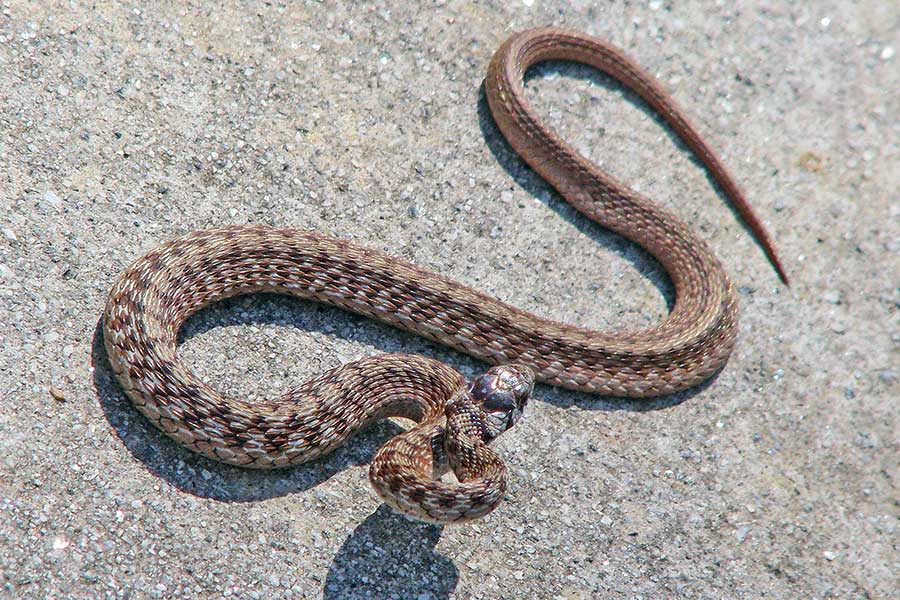
Dekay’s brown snake is 9-13 inches long.
This snake is typically a brown that can be gray to reddish in tone with a tan stripe and darker spots. The head is dark.
You can find this snake everywhere in Missouri, but they are rarely seen since they prefer to hide under debris where it is humid.
They eat earthworms, slugs, snails, and other soft-bodied prey. They are most commonly seen in gardens where they hunt for common pests.
Red-bellied Snake (Storeria occipitomacula)
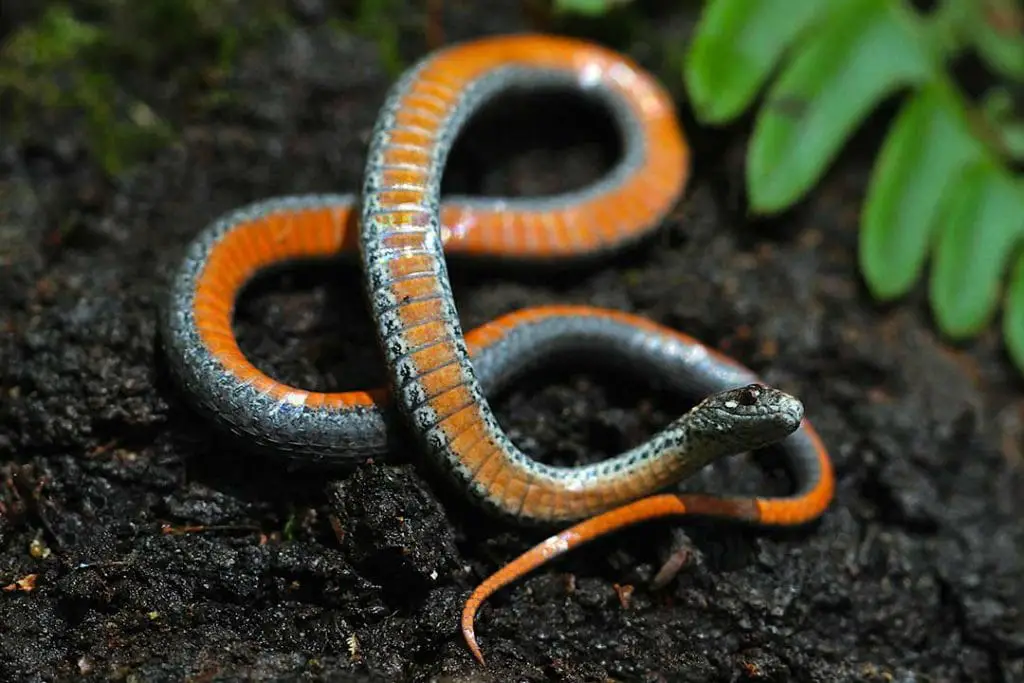
The red-bellied snake is a small snake at only 8-10 inches.
They are gray-brown or reddish-brown with 4 dark stripes. They also have a faint tan stripe down the back. The head is dark with 3 light spots that can join to form a collar. The belly is orange, red, yellow, or pink.
You can find the red-bellied snake in most of Missouri aside from the northwestern corner.
They eat primarily earthworms and slugs, but they will eat other soft-bodied insects.
Green Snakes (Opheodrys)
Rough Green Snake (Opheodrys aestivus)
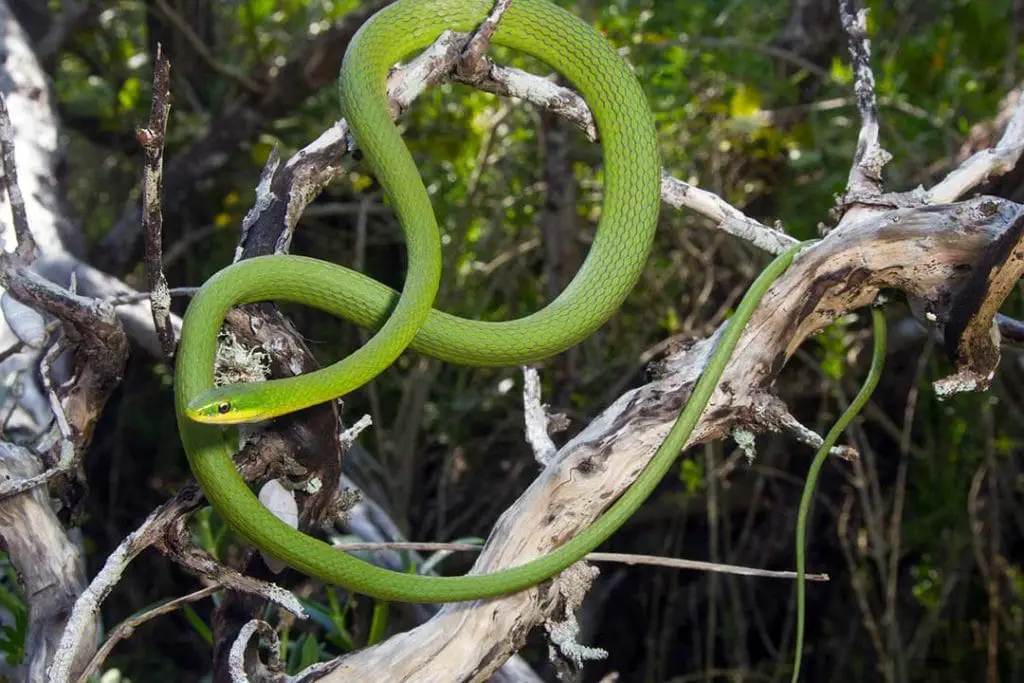
The rough green snake is a slender, arboreal snake that is 22-32 inches.
They are bright green with a yellow or cream belly. They are named for their rough scales, which sets them apart from the similar smooth green snake.
They live in bushes, low-hanging branches, and vines close to streams and lakes. They can be found in most of the state aside from the upper third.
They are insectivores and eat spiders and soft-bodied insects. They are unique because they lose their color when they die.
They turn a bluish color not long after death, which can mean dead animals are not properly identified. Most sightings of this snake are when they are crossing paths or roads since they blend into the bright leaves of the plants they live in.
Smooth Green Snake (Opheodrys vernalis)
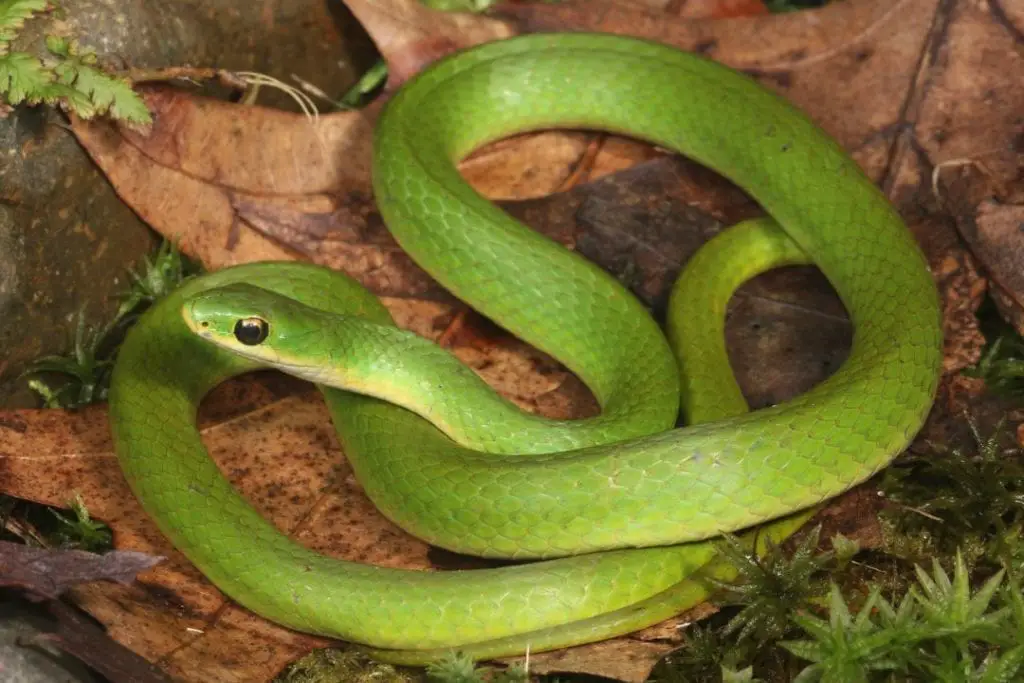
Smooth green snakes are 14-20 inches long with a bright green back.
They have a yellow or cream belly with smooth, shiny scales. Their main habitat was the grassy meadows of the northern half of the state.
The diet consists of spiders, slugs, and insects. This species has not been collected from Missouri since the 1950s, so it may be extirpated.
Like the rough green snake, they turn a pale blue once the animal dies.
Rat Snakes (Pantherophis)
Eastern Fox Snake (Pantherophis vulpinus)

The eastern fox snake is 36-54 inches long.
They are gray, yellow, tan, or greenish-brown with 43 brown blotches. Juveniles are gray with dark blotches.
They are only found in a few counties by the Mississippi River to the north of St. Louis. Adults eat small mammals and birds, while juveniles eat frogs and insects.
They are named for their musk that smells similar to the smell of the red fox.
Western Fox Snake (Pantherophis ramspotii)
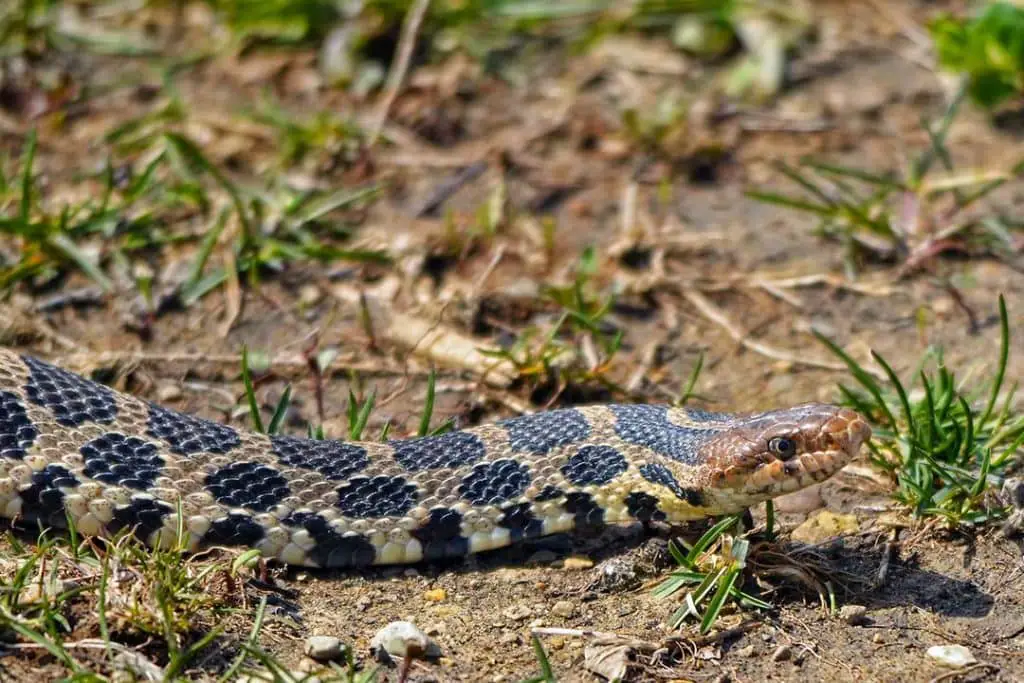
Western fox snakes are 36-54 inches long with brown blotches.
The background color is tan, yellow, or greenish-brown with numerous blotches on the back and sides. The head can be orange.
Juveniles tend to be gray with a black mask over their eyes.
They prefer marshy habitats in the northwestern corner of the state. Adults eat rodents and birds as well as bird eggs. Young western fox snakes eat frogs and insects.
They were named for Joseph Ramspot, a graduate student in herpetology working in the Crother-White lab when he passed away.
Great Plains Ratsnake (Pantherophis emoryi)
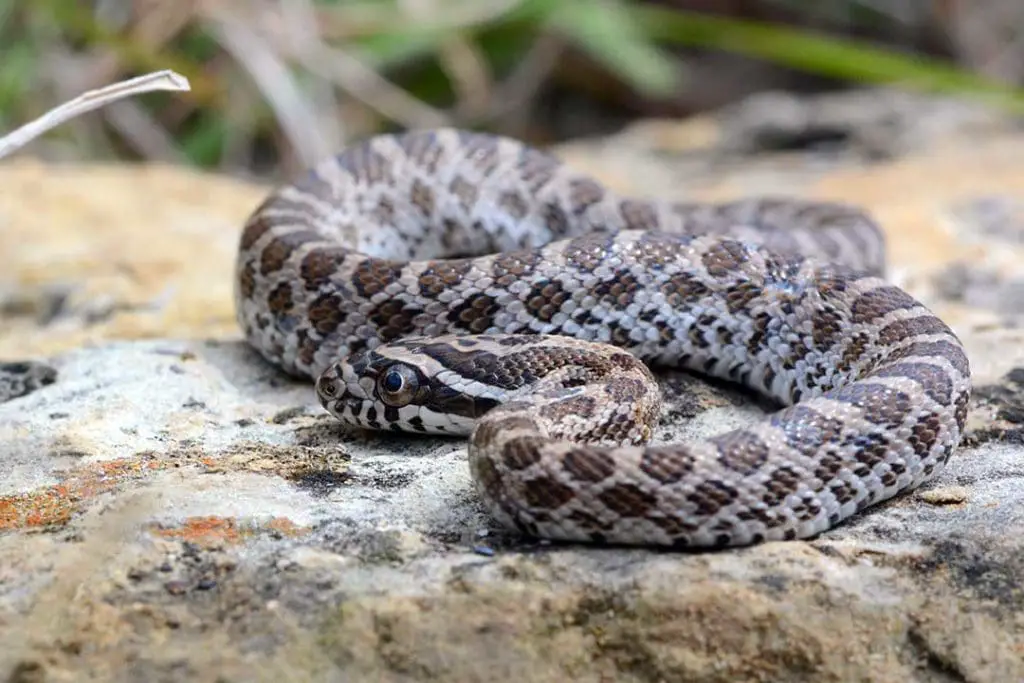
The great plains ratsnake is 24-36 inches long with a gray body and brown blotches.
The head has a spearpoint marking and a stripe over the eyes like a mask. The belly is white with black squares over most of it and gray stripes near the tail. The prairie kingsnake is similar but has a different head marking and lacks the eye stripe.
The kingsnake also has a yellow belly with brown markings.
The great plains ratsnake is found in the southern woodlands and along the Missouri River, but they are not found in the southeastern corner. They eat a wide range of prey including small mammals, birds, and bats. They hunt mainly at night and are rarely seen.
Western Ratsnake (Pantherophis obsoletus)
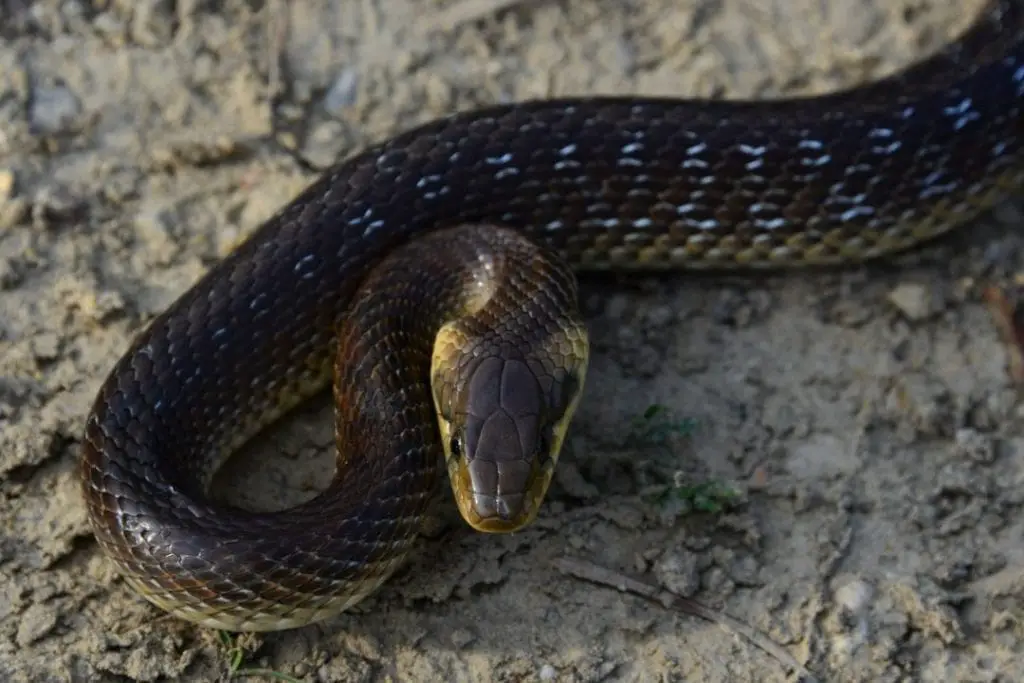
Western ratsnakes are one of the largest snakes in Missouri. They are 42-72 inches.
They are typically shiny black but they can have dark brown blotches. The upper lip, neck, and chin are white. Juveniles are gray or tan with dark patterning.
This black rat snake lives statewide and may breed with gray ratsnakes in the bootheel area. They eat a wide range of vertebrate prey. They are also known to climb trees to raid bird nests.
Ring-necked Snakes (Diadiophus)
Ring-necked Snake (Diadophus punctatus)
There are two subspecies of ring-necked snake in Missouri. Both eat mainly earthworms but they will also eat slugs and other soft-bodied prey. They also tend to coil the tail and display a bright belly when threatened.
The prairie ring-necked snake (D. p. arnyi) is the more common subspecies in Missouri. They are 10-14 inches long and have a black, gray, or dark brown back.
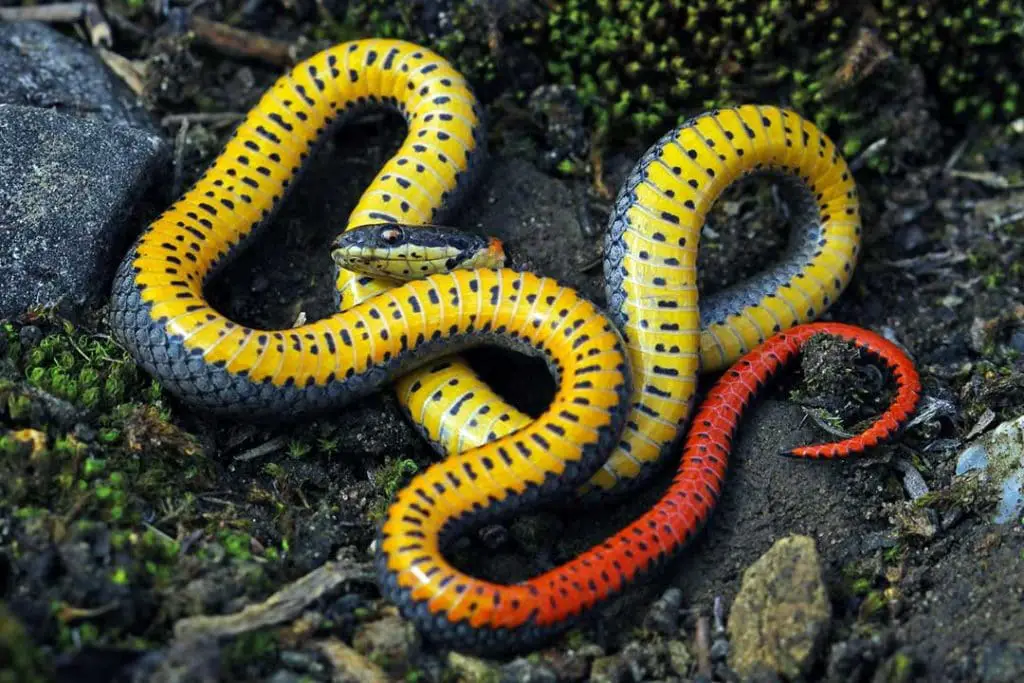
The neck has a light ring around it. The belly is yellow and shifts to orange along the tail with irregular black spots. They are found in most of Missouri aside from the bootheel.
The Mississippi ring-necked snake (D. p. stictogenys) replaces the prairie ring-necked snake in the bootheel region. They are smaller and have a thinner neck ring. The belly is a solid yellow and the belly spots are in rows.

Bull Snakes (Pituophis)
Bull Snake (Pituophis catenifer sayi)

Bullsnakes are a subspecies of the gopher snake.
They are 37-72 inches long with a tan, cream, or yellow background and numerous dark blotches. The markings tend to be darker on the head and tail and lighter in the middle of the body.
The belly is light with dark checkering. They can be found over most of the state aside from the southeastern corner. Bullsnakes are known for their incredibly loud hiss and unique strike position.
These gopher snakes will either bite or calm down quickly when handled. This species is very beneficial to farmers, but it is considered to be a conservation concern.
Coachwhips (Masticophis)
Eastern Coachwhip (Masticophis flagellum)
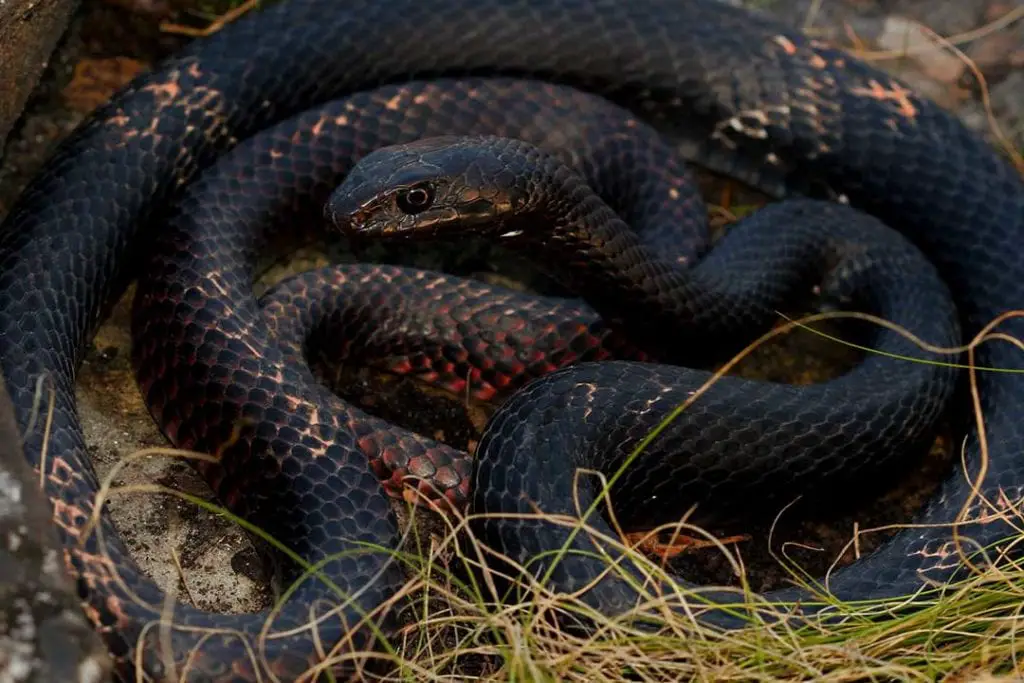
The eastern coachwhip is a slender snake species that tends to be 42-60 inches long.
They are dark brown or black at the head and fade to tan, light brown, or reddish black.
Some animals in southwestern Missouri are entirely dark brown or black. Young snakes are tan with dark crossbands only on the front half of the body that fades towards the tail.
They are found in the southern half of the state aside from the southeastern corner. Coachwhips will hunt nearly anything they can catch and have been known to climb trees to raid bird nests.
Scarlet Snakes (Cemophora)
Northern Scarlet Snake (Cemophora coccinea copei)
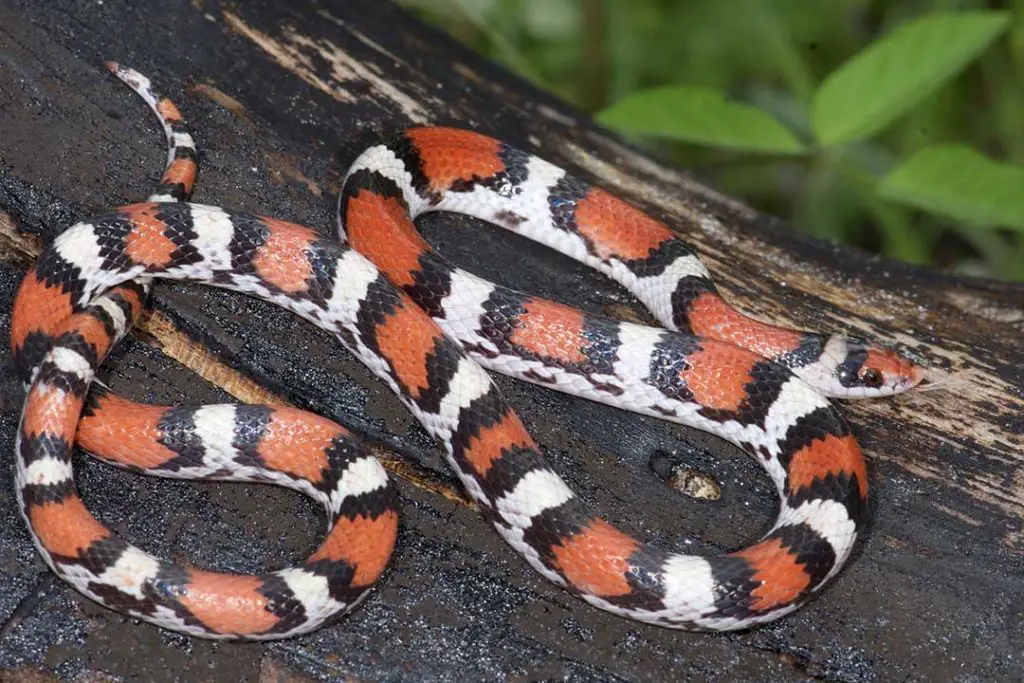
The northern scarlet snake is 14-20 inches long with a pointed head.
They are white or yellowish with large red blotches partly bordered in black. The snout is red or orange and the belly is white or cream without any patterning. They look similar to the red milksnake and the coral snake.
Coral snakes do not live in Missouri and the red milksnake typically doesn’t have a red or orange snout and the belly on a milksnake is patterned. T
hey are only found in a few scattered counties in the south-central and southern parts of Missouri. The vast majority of the diet is made up of reptile eggs, but they may also eat lizards, snakes, and small rodents.
Kirtland’s Snake (Clonophis)
Kirtland’s Snake (Clonophis kirtlandii)

Kirtland’s snake is a threatened species that is incredibly rare in Missouri.
They are 14-18 inches long and reddish-brown with two rows of dark spots on the sides. They have a red or pink belly with rows of black spots.
They are only found around the Mississippi River in the northeast part of Missouri. They live in crayfish burrows found in grasslands by bodies of water.
They eat mainly earthworms and slugs, but they will also eat crayfish and small fish. They are considered to be threatened because they have small populations in only a few states.
They are very vulnerable to habitat loss since they need such specialized conditions.
Racers (Coluber)
Yellow-bellied and Black Racers (Coluber constrictor)
There are two subspecies of racer native to Missouri. Both species eat a wide range of prey including amphibians, lizards, snakes, and insects. They use their speed and strength to chase down prey.
The eastern yellow-bellied racer (C. c flaviventrus) is 30-50 inches and slender.
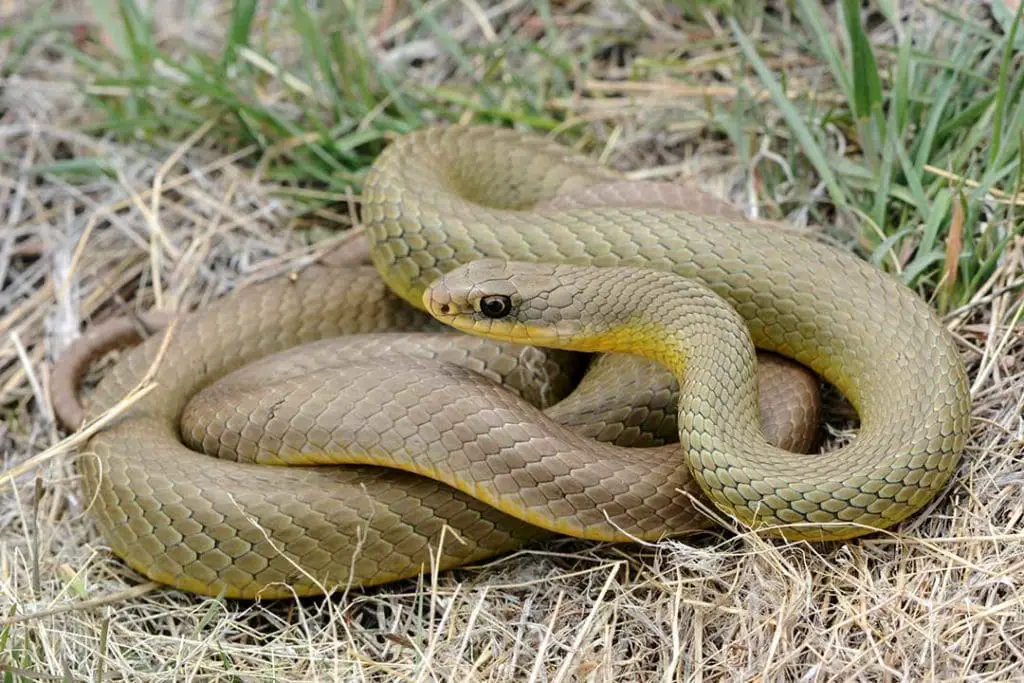
They can be several colors including olive, brown, tan, blue, gray, or nearly black. The belly is cream, yellow, or blue-gray. Juveniles are tan with dark blotches that fade by 3 years of age.
It lives all over Missouri aside from the southeastern corner.
Southern black racers (C. c. priapus) replaces the yellow-bellied racer in the southeastern corner of Missouri.
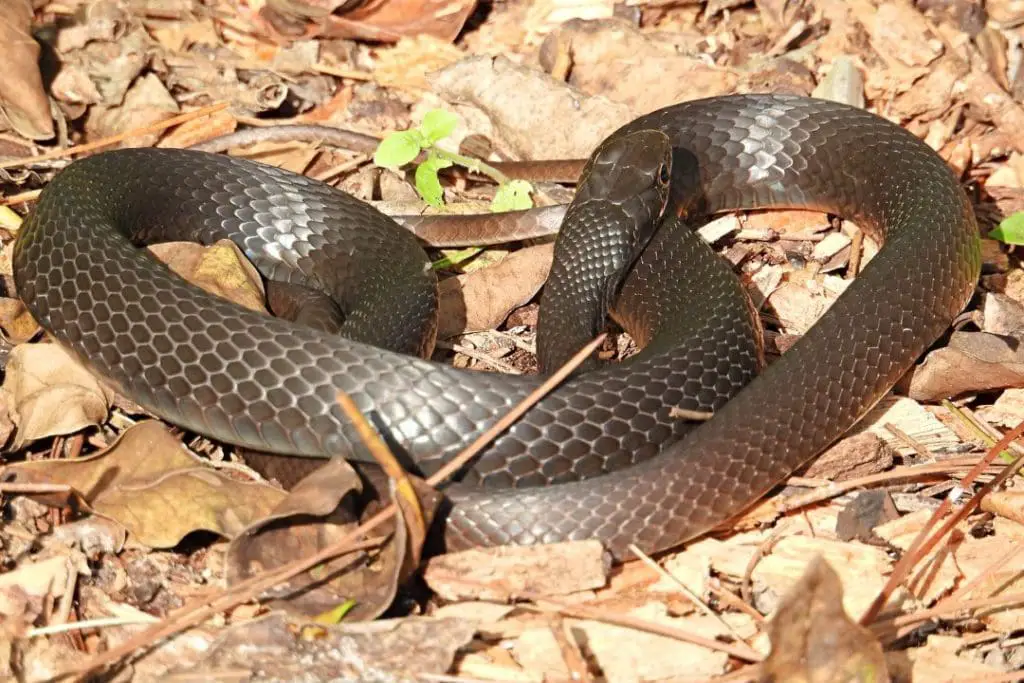
They are 20-56 inches long with a slender black or bluish-black with a white belly and chin. Juveniles are gray with reddish-brown blotches.
Lined Snakes (Tropidoclonion)
Lined Snake (Tropidoclonion lineatum)
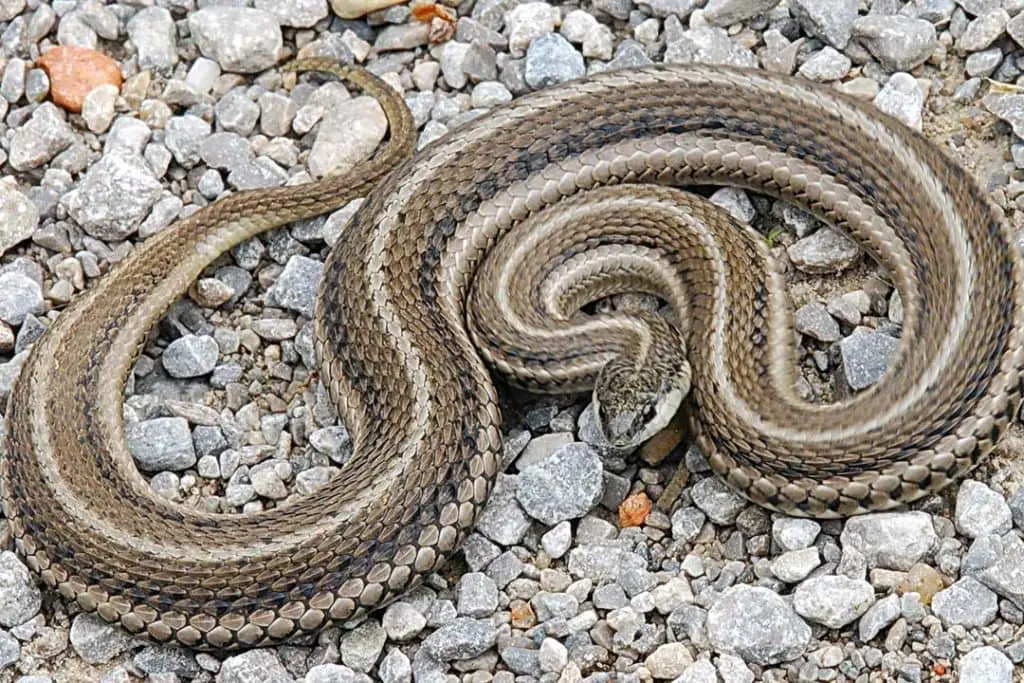
Lined snakes are 8-15 inches long. They are brown to grayish-brown with light and dark stripes going down the body.
The light stripes tend to be light gray, white, or yellow while the dark stripes are olive-gray, dark gray, or grayish-brown.
These snakes are easy to confuse for garter snakes, but the lined snake has more stripes while garter snakes only have three and no dark stripes.
They can be found mainly in the western part of the state, but they are also found near St. Louis and in the northeast. They eat earthworms and spend most of their time hiding.
Flat-headed Snakes (Tantilla)
Flat-headed Snake (Tantilla gracilis)
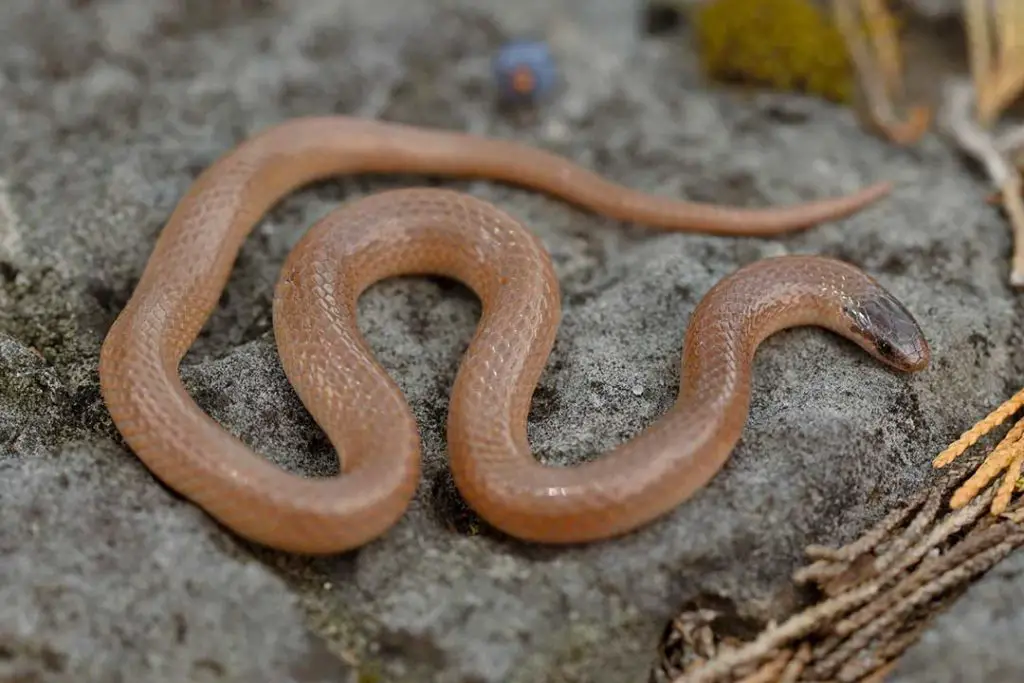
Flat-headed snakes are the smallest snakes in Missouri. They are 7-8 inches long and very thin. They are gray, tan, or reddish-brown with smooth scales. They can have a dark heads.
They have a salmon pink belly which is the easiest way to tell them apart from earthsnakes. They are found in the south of the state aside from the southeastern corner.
They eat mainly centipedes but will take insects and larvae. They are burrowers and are rarely seen.
Crayfish Snakes (Regina)
Graham’s Crayfish Snake (Regina grahamii)
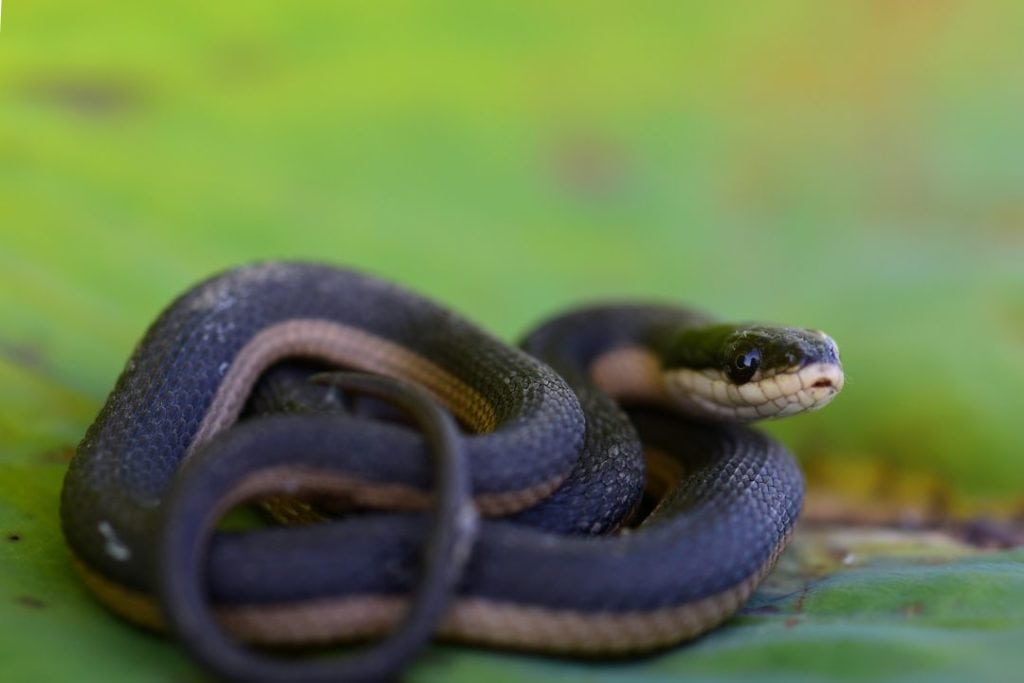
Graham’s crayfish snake is a dull-colored snake that is 18-28 inches long.
They are brown or yellowish-brown with yellowish-tan stripes on the side. They live in most of the state aside from the Ozarks. These are semi-aquatic snakes that live in streams, ponds, and marshes.
The main part of their diet is freshly-molted crayfish, but they also eat frogs and tadpoles. These snakes give birth to live young and average of 16 babies in a single litter.
Mud snakes (Farancia)
Western Mud snake (Farancia abacura reinwardtii)
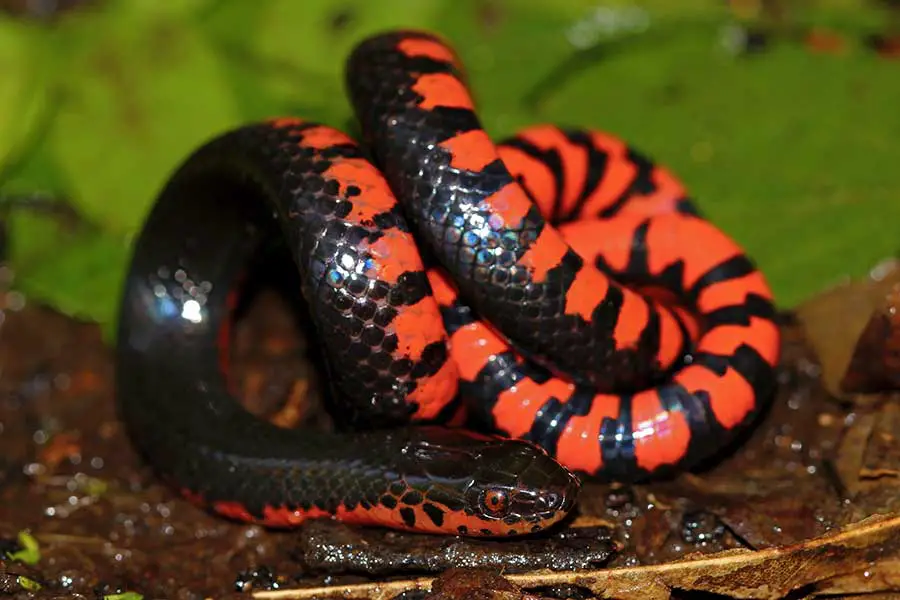
The western mudsnake is 40-54 inches long and iridescent. The top of the snake body color is black and the belly is red, pink, or orange and can have some black spots and banding.
Mud snakes live in swamps in southeastern Missouri. They eat primarily lesser sirens and amphiumas. These are eel-like amphibians that tend to curl up when attacked.
The western mudsnake has a pointed tail tip that it uses to prod its prey to make it uncoil so it can eat it more easily. Since they only live in natural swamps, they are at risk of habitat loss.
Groundsnakes (Sonora)
Variable Groundsnake (Sonora semiannulata semiannulata)
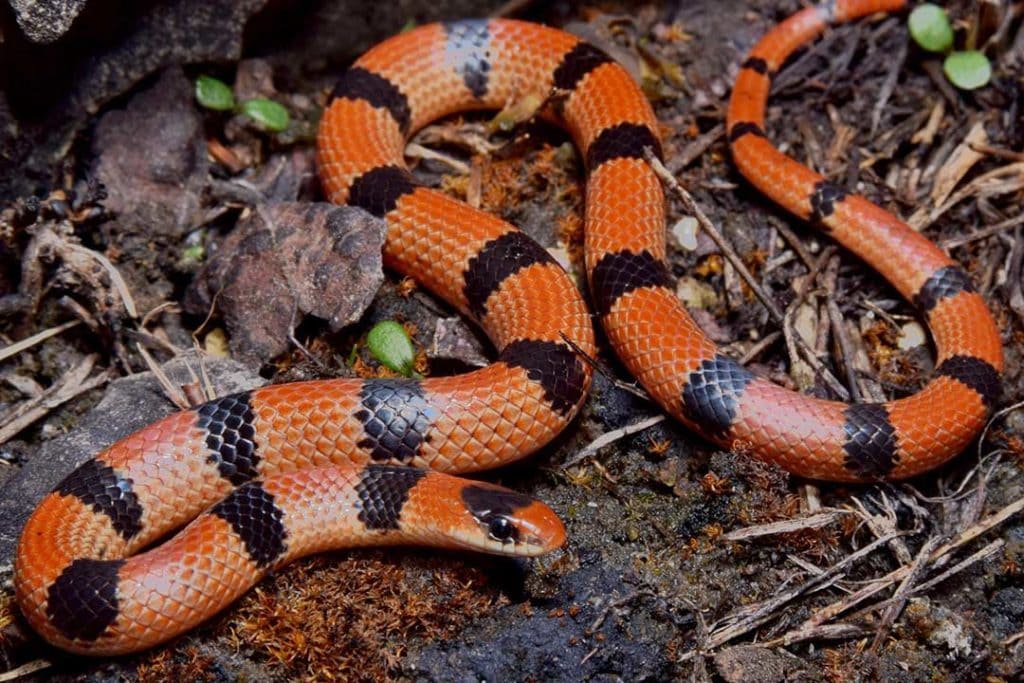
The variable groundsnake is a small snake that is only 8-12 inches long. They have a wide range of colors and patterns with shiny scales. They can be brown, orange, red, or light brown.
The pattern can be dark bands, blotches, or entirely patternless. They are found in a few counties in the southwest of Missouri. They live in rocky glades and meadows on south or southwest-facing slopes.
They rest under flat rocks and will burrow on hot days. They are insectivores and eat spiders, scorpions, centipedes, and soft-bodied insects.
Rough Earthsnakes (Haldea)
Rough Earthsnake (Haldea striatula)
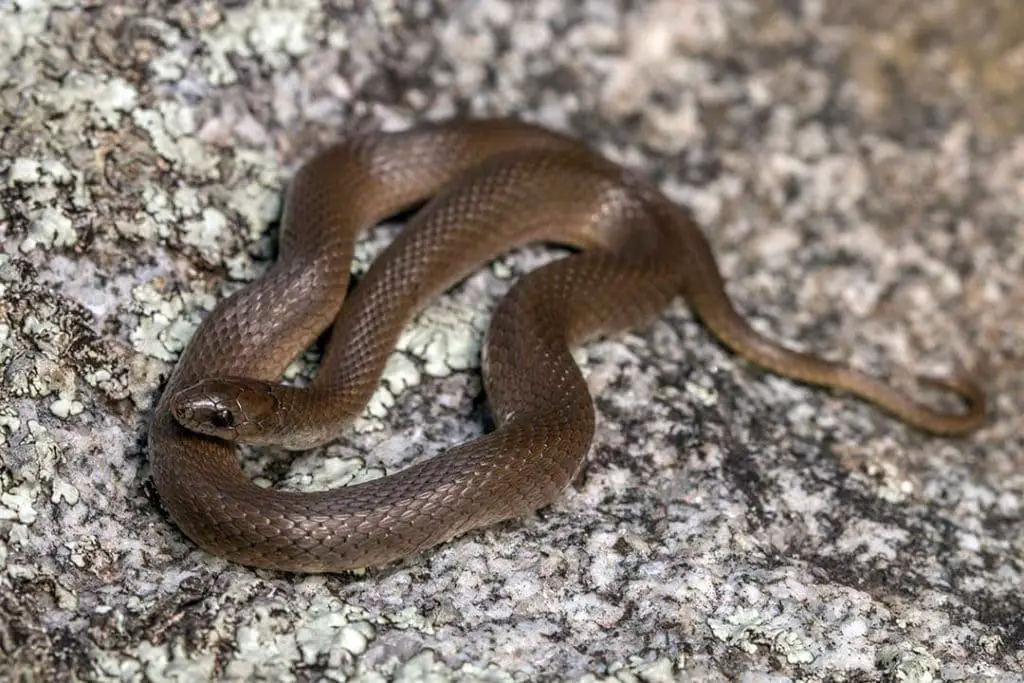
The rough earthsnake is small and rarely seen due to their burrowing habits. They are 7-10 inches long with gray, brown, or reddish-brown back. They have an unmarked belly that is cream or light gray.
They can easily be told apart from the smooth earthsnake thanks to the keeled scales and a single scale between the nostrils. You can find them on rocky hillsides in the Ozarks in the southern half of the snake.
Earth snakes cannot be found in the southeastern corner of the state. The primary diet is earthworms, but they will eat other soft-bodied invertebrates.
This species used to be in the Virginia genus, but they have been moved to their current classification.
Smooth Earthsnakes (Virginia)
Western Smooth Earthsnake (Virginia valeriae elegans)
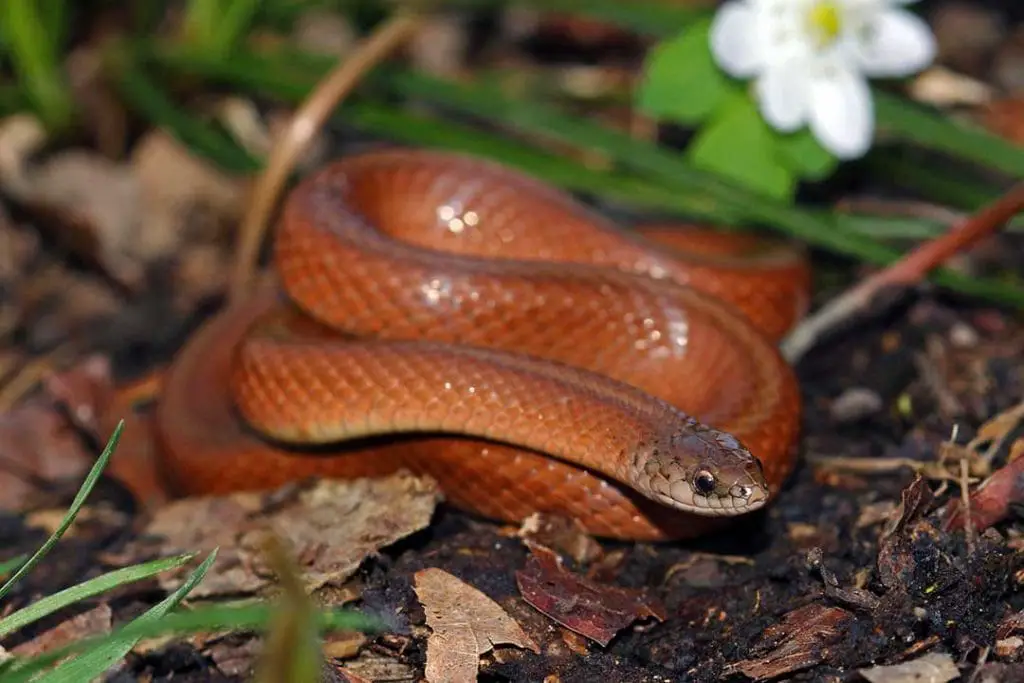
The western smooth earthsnake is 7-10 inches long with a conical head and stout body for its size. They are gray or light to reddish-brown without any distinct patterning.
The belly is white or cream. This species can be told apart from the rough earthsnake by its smooth scales, 2 scales between the nostrils, and having 6 scales on the lips.
They live statewide aside from the northwest corner. Most of the population is in the southern half of the state. The main diet is earthworms, but they will also eat slugs and insects.
Wormsnakes (Carphophis)
Western Wormsnake (Carphophis vermis)
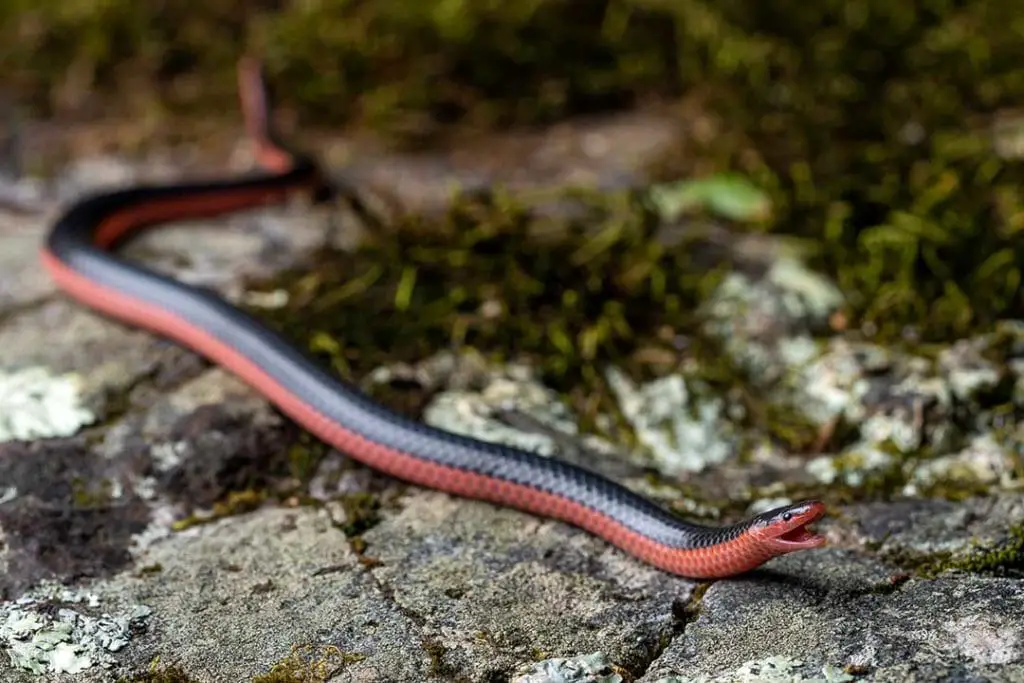
Western wormsnakes is a small, two-toned burrowing snake species. The back is typically a purplish-brown while the belly and sides are a pinkish-orange.
The head is flat and the tail ends in a spike to aid in burrowing. The western worm snake lives in most of the state aside from the tip of the southeast corner and a few counties in the south-central part of Missouri.
These harmless snakes eat earthworms, soft-bodied insects, insect larvae, and eggs. They live on rocky wooded or open hillsides and spend most of their time under debris or burrowed into soft soil.
Venomous Snakes
Venomous snakes are any snake species that has a venom that can harm humans.
Any bite should get immediate medical attention. Always watch where you walk and try to give any snakes you run into plenty of room to flee from you.
Venomous snakes only bite if they feel threatened or cornered. Give them space and you will be fine.
The venomous species in Missouri are:
Pit Vipers (Crotalinae)
Eastern Copperhead (Agkistrodon contortrix)

The eastern copperhead is a thick-bodied snake that is typically 24-36 inches but can reach 53 inches long on occasion. They are copper, gray, tan, or pinkish with dark brown hourglass markings.
It has a blocky head with a heat pit under the eyes and vertical pupils.
Babies look similar but they have a bright yellow tail tip. It can be found in most of Missouri aside from the furthest northern areas of the state. They eat mainly mice or voles, but they will eat nearly anything including small snakes.
Northern Cottonmouth (Agkistrodon piscivorus)

The northern cottonmouth is a heavy-bodied snake that averages 30-48 inches but can reach up to 75 inches. Adults are dark brown or olive and have minimal patterning.
Some adults are nearly black. They have a blocky head with a white upper lip and may have a dark stripe going from the face. They have a heat pit on the face and a vertical pupil.
Young snakes are lighter with visible crossbands. They are born with a bright tail-tip, but it fades as the snake ages.
They are found mainly in the southeastern part of the state with scattered populations in the Ozarks. They are scarce and most snakes seen in the water are typically harmless Nerodia snakes.
They mainly use their venom for hunting fish and frogs, but this venomous species will eat nearly anything including other snakes. They will also eat roadkill and carrion, which is not typical for most snakes.
Prairie Massasauga (Sistrurus tergeminus tergeminus)

Prairie massasaugas is an endangered venomous snake found only in isolated populations in the northwestern corner and the north-central portion of Missouri.
Most animals are 18-30 inches long but some can reach 35 inches. They tend to be some shade of gray with 34-50 brown or black blotches on the back with more on the sides.
Like all rattlesnakes, they have vertical pupils, a heat-sensing pit, and a rattle on the tip of the tail. They are born with a single “button” rattle and more segments grow with age.
Adults eat mainly voles and babies may eat other prey including snakes. The eastern massasauga (S. catenatus) was once found in the floodplains of the Mississippi River north of St. Loius.
They have not been seen in Missouri since 1941.
Timber Rattlesnake (Crotalus horridus)
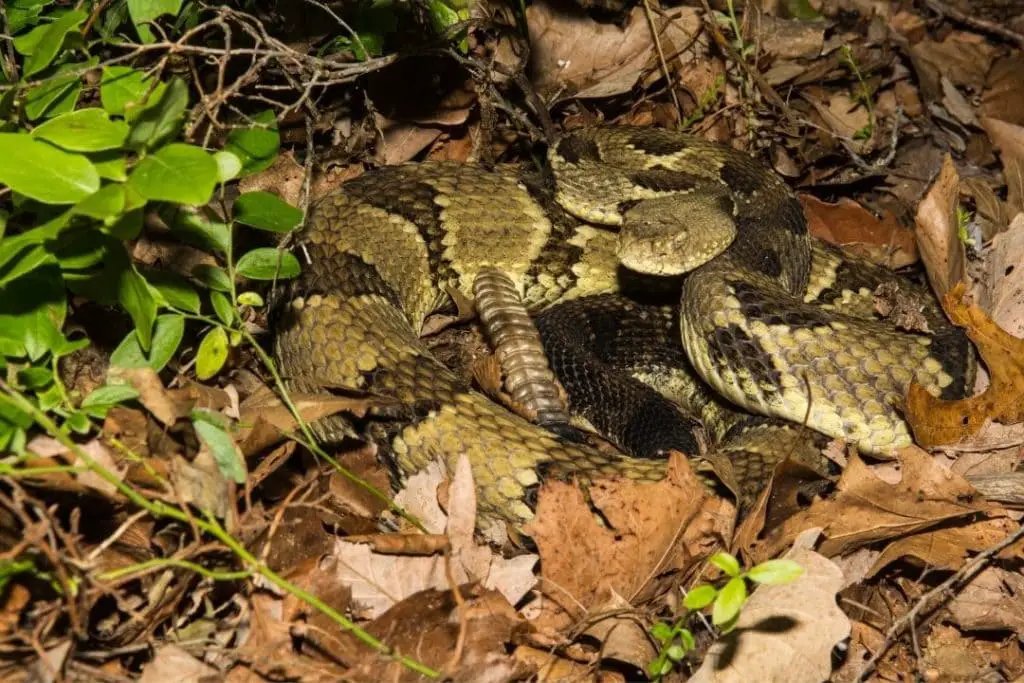
The timber rattlesnake is the largest venomous snake in Missouri. They average 36-60 inches, but they can reach 75 inches long. They are ta, brown, yellow, or gray with dark markings.
The markings are rounded near the head and change to bands or v-shaped lines from the middle of the snake to the tail. The tail itself is black with a rattle.
The top of the head is unmarked and tan, yellow, or gray. They have a large head with a heat-sensing pit under the eyes. They can be found statewide, but the species has been eliminated from some counties.
Missouri’s largest venomous snake eats rodents, rabbits, and birds. The venom helps them kill their prey with less of a risk of the prey injuring the snake.
Western Pygmy Rattlesnake (Sistrurus miliarius streckeri)
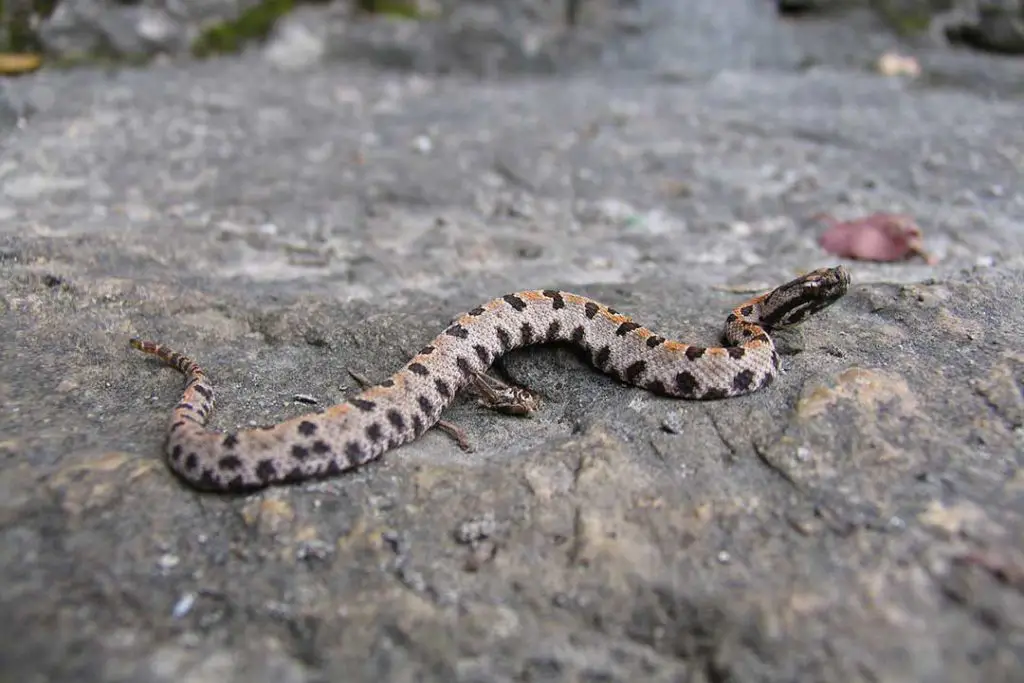
Western pygmy rattlesnakes are one of the smallest rattlesnakes at only 15-20 inches. They are brownish-gray with darker blotches.
The dorsal blotches are rounded or bars while the blotches on the side are smaller. They frequently have an orange-brown dorsal stripe.
The tail has dark bands and ends in a rattle. They live in the Ozarks, St. Francois Mountains, and the southern border with Arkansas.
This common venomous snake eats small prey like lizards, snakes, mice, insects, and frogs. The rattle sounds similar to a grasshopper and generally can’t be heard from more than a yard away.
Frequently Asked Questions
Where are Rattlesnakes Found in Missouri?
Rattlesnakes are found over most of Missouri. They tend to live in wooded areas with plenty of cover.
Where are Copperheads Found in Missouri?
Copperheads are found in most of Missouri aside from the northern border. They tend to prefer areas with plenty of cover where they can hunt.
Are There are Snakes in the Ozarks?
There are snakes in the Ozarks. Some snakes are not found there, but many snakes still call the Ozarks home.
Conclusion
There are many snakes in Missouri and the united states. You can find a snake nearly everywhere in the state. If you have any questions or comments, please leave them below.
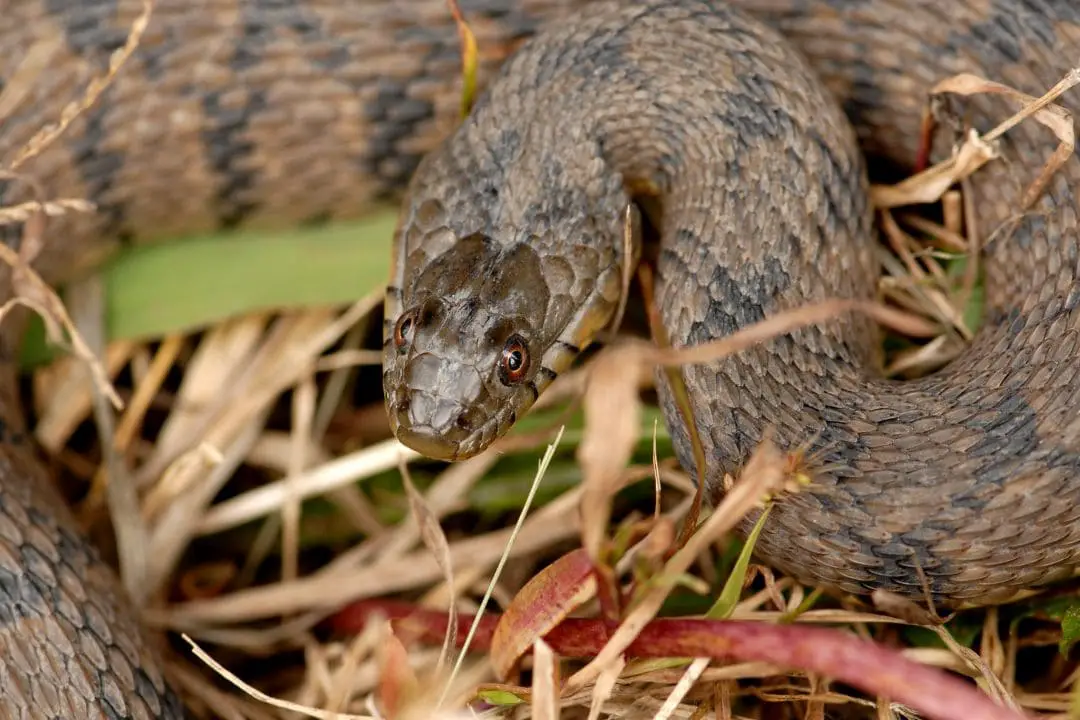
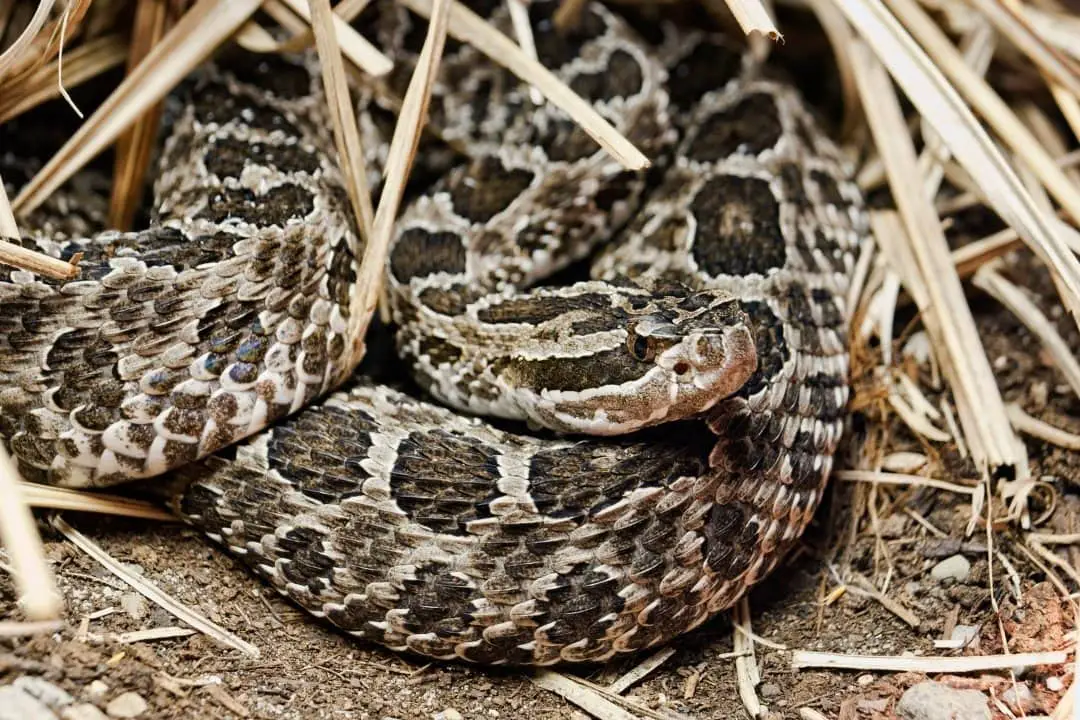
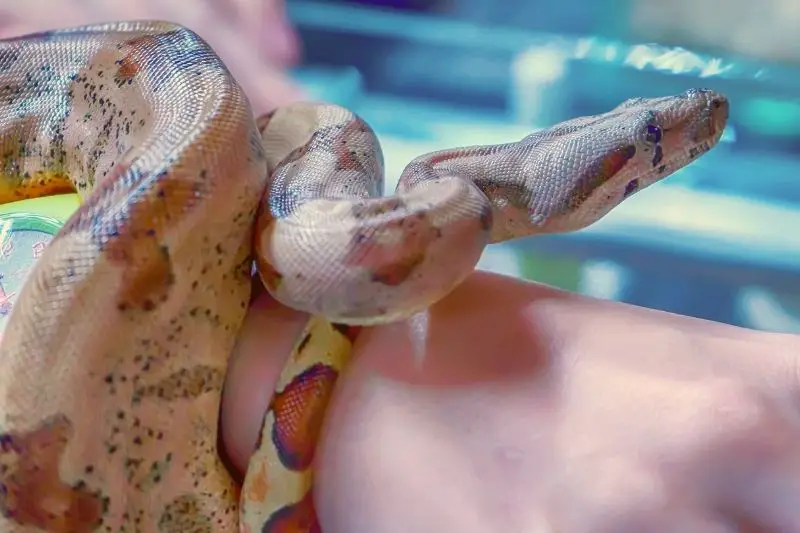
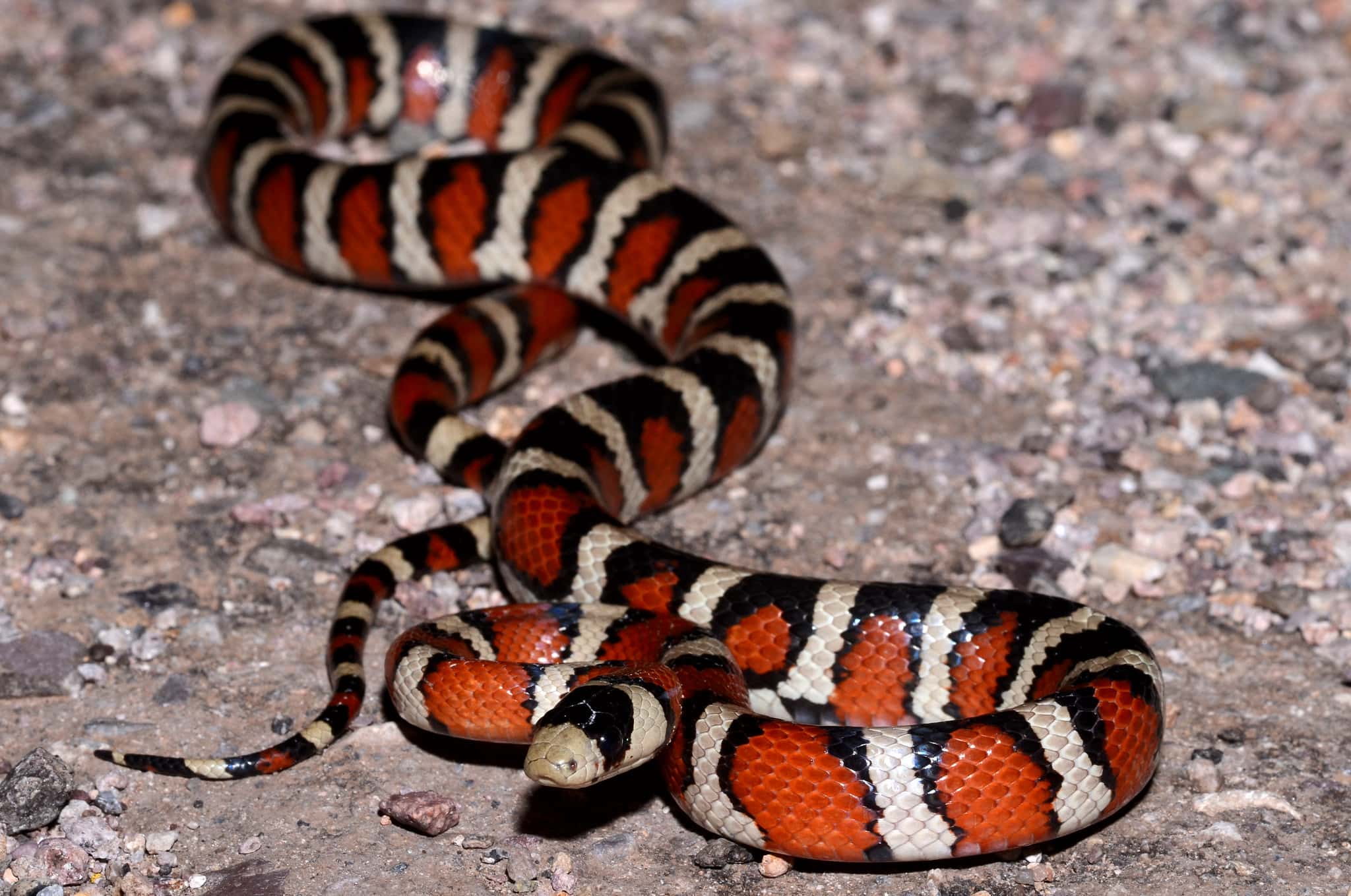
Hi Rudy,
Sometimes we get mice in our attic in our country cabin near Cuba MO. on a very rare occasion we’ll even get a snake in the attic. In the past, the snakes were always a solid color. I would guess that they were black snakes. Recently, I’ve seen a snake that appears to have some marking on it. It’s also much smaller than the solid colored snakes in the past.
I’ve uploaded a video of this snake (to my onedrive) trying to get a mouse out of one of the snap traps. It’s dark in the attic, so the camera is using the infrared light. If you can download this video, perhaps you can let me know what kind of snake this is. The bucket the snake is crawling around is a 5-gallon bucket.
Here’s the link:
https://1drv.ms/v/s!ArNNeN2TMTDchqlFLOobp4mB6PN8Tw?e=a73gCa
It’s about 262 MB in size.
I
A very small snake, about 8-10 inches with diameter of less than a pencil, was on the screened porch. It slid under the siding then came back up. My husband swept it outside but not far away. It was dark with a diamond pattern and a flat triangular shaped head. Is this a snake I should be concerned about possibly wintering under the porch and growing bigger? Is it venomous?
Good day. Came across a small snake while uncovering my hydrangeas and roses (I mulch them with leaves prior to a deep freeze and uncover after the last freeze. This small, thin snake had a black head, about 9 inches in length, very slender. tan in color with 2 dark brown stripes down its body that start at its’ neck, which also has a dark colored necklace look. Any idea what this little rascal may be? I am guessing it was looking for worms and bugs in the mulched leaf pile, as it was laying atop of one pile. Thanks in advance,